Power Trips — SFO’s Luxpedition’s for Billionaires: — Making Sacred Space Through New Age Pilgrimage

X-treme Luxury Travel for Billionaires: Luxpeditions

- A small percentage of people live by the unwritten rule of extremes.
- All of which is an impossible for these people is normal.
- And normal for them is boring.
- Locations are extreme, whether they are the thin edge of the cliff, the desert or the tallest skyscraper of the world everything is extremely attracted to adrenaline junkies.
- Our Extreme Shop provides that extreme experience to the go getters* https://bit.ly/3g6iSKE
- Extreme Sports — https://bit.ly/3gbtE2o
- Extreme Art & Entertainment — https://bit.ly/2TPcL6l
- Extreme Events — https://bit.ly/3pCeh7H
- Extreme Indulgence — https://bit.ly/3z8qQMj
- Extreme Performance — https://bit.ly/3z5Rfdx - Experiences are the new possessions. Transformational travel is the new authenticity. Expeditions are the new vacations.
- By now, anyone who has been paying attention to the world of travel knows these things. But even as we’ve watched this evolution unfold, there are quite a few of us who aren’t ready to let go of our creature comforts. We may no longer need dedicated butlers and Italian linens, but we don’t necessarily want to carry a 40-pound backpack and pitch our own tent.
- Which is where Sekhon Famly Office’s new soft-but-serious adventure trips come in.
- Everyone’s 2021 travel predictions, from sources as varied as Booking.com and JW Thompson Intelligence — Future 100, envisioned a travel landscape marked by more remote and challenging destinations (what JTW called “anti-luxury luxury”).
- Maybe it’s Bear Grylls’s fault. Maybe it’s Blue Planet’s. Maybe it’s the steady stream of coolness and badassery we’re constantly consuming on social media. But something is making us want to explore and to be physically and intellectually challenged. But, you know, comfortably.
- That’s exactly what SFO’s “Luxpeditions” offer. Granted, plenty of other companies have been playing in this space for a while, including Black Tomato, GeoEx, Explora and Eleven Experience. But SFO gets some credit for coining a catchy term and giving a name to our luxury travel desires: an actual expedition elevated to the highest realms of comfort, pleasure and exclusivity.
- Our “Luxpeditions” offer travel and stay in Jets, Yachts, Ultra Luxury Cars, Palaces and the best cuisine / culture experience.
- Here we narrate the “Power Trips — Luxpedition Series for Billionaires: — Making Sacred Space Through New Age Pilgrimage ” across all the energy vortices across the globe.
- A Luxpedition is for those who want their Bear Grylls experience during the daytime but, at night, want to blast away the dust, dirt and sweat with a power shower and slip beneath crisp, clean sheets. Or maybe, somewhere along the trail, they’d like a loved one helicoptered in to join them — so they can share in the excitement for a night or two.”
- Each trip is one of a kind, but so far their clients have explored the earth’s uncharted jungles, deserts and mountain peaks. Here’s an example: Eight hours into a 12-hour Middle Eastern camel trek with the sun showing no mercy, clients found ice-cold glasses of their favorite craft beer waiting for them by the cool shade of an oasis.
- Another: After a day of driving a pack of huskies across Kamchatka’s frozen tundra in the Russian Far East, clients were mightily relieved to welcome the idea of bedding down that night in a luxury tent with under-floor heating. And a third: Feeling the adrenaline from sand-boarding down the ashen slopes of a Nicaraguan volcano, guests savored a decadent picnic that included local rum and cigars. And that was before they moved to a boat off the coast of Costa Rica, where they were joined by a team of marine biologists and given access to all sorts of aquatic toys, including a custom-built one-atmosphere submarine, capable of carrying a pilot and two passengers to a depth of 1,500 feet and giving them 360-degree views.
- And here is where the metaphor of the swan comes into play. On the surface, everything seems to float along placidly. Underneath, there’s some furious paddling going on. Creating itinerary for each of these trips — and the same goes for custom trips designed by other luxury adventure operators — involves hundreds of man-hours of planning and draws on the company’s extensive network of on-the-ground experts, who are more likely to be documentarians and researchers than run-of-the-mill tour guides.
- Of course, all this comes with a price. SFO is the first to say that our audience is cash-rich time-poor UHNWI who understand what it’s like to live with extreme pressure in their work lives. Taking them out of the office and into nature but giving them something that plays to their steely determination and competitive spirit is the perfect release. The result is a different sense of achievement and fulfillment.
Oh, and some pretty good bragging rights.

- Places around the world that are regarded as sacred are nothing new. From the formation of Stonehenge to the power and sanctity of the Hawaiian Islands, energy vortexes of Sedona, and chakra centers around the world, there’s no doubt there are some places where more people feel a deep connection to the Earth and Universe.
- We know about the main vortexes of energy in the human body — chakras, and quite naturally Gaia, mother earth too has Chakras. How we have energy flowing through our body, the earth too has an energy flow that seems to be quite a topic of interest.
- And these vortexes are found along the ley lines.
EARTH VORTICES & CHAKRA POINTS IN RELATION TO THE EARTH-ANTHROPOMORPHIC MAN

Earth -Man Circuit Theory

- It has long been established that the Earth has symmetry and circuitry corresponding to that of the Human Form in terms of Energy Vortices and Pressure Points. The Earth-Man Circuit Theory seeks to provide a unifying context that incorporates the Earth’s Energy Points, i.e., Chakras. The Earth’s Vortices Theory relies on Sacred Geometry with reference to the 188 Day Cycle. The link between these 2 Theories and the Earth-Anthropomorphic Man ‘picture’ or Earth circuitry is the factor of the Golden Ratio. This is observed on the opposite ends or the hemispheres
of the Earth as it is with the Human Form. The Human Form or body correlates in proportion to the Earth’s Longitudes and Latitudes. The ratio appears to close the circuit at peculiar point or areas of the Earth that also appear to correspond with certain Energy Points & Pressure Points.
THE GOLDEN RATIO
- It is the ’Signature of the Creator’. This ratio is witness in math, nature, arts and the human Form/Body. It is when 2 quantities are in the golden ratio if the ratio of the sum of the quantities to the larger quantity is equal to the ratio of the larger quantity to the smaller one. Interestingly, this ratio is linked to the 188 Day Cycle Theory by formula related to the Earth:
Φ/π X 365 DAYS = 188
THE REDPEMPTION OF THE HUMAN BODY


- According the Sacred Hebrew Scriptures, Humanity is the Crown of YHWH’s Creation made in His Image and likeness as told in Genesis 1. The human body functions in frequency, cycles of cell regeneration (7 Years) etc. GOD fashioned the 1st humans out of the red clay of Earth and fused it to life -a living Soul from the very Breath of God (Chi). Humanity is both physical and spiritual. Due to sin, the human bodies decay and die as they are composed of the base elements of Earth itself. This death and decay
was not the original plan, thus the spirit, soul and body of a human had to be redeemed by the physical Body and Blood of one that was not subject to such death. This was Jesus Christ. At the Cross, GOD now can enable the soul, spirit and body of humans to be ‘Reborn’ and thus commune once more directly with GOD the Father through Christ the SON in and by the power of the Holy Spirit (Pneuma) because of Christ. - Jesus’ Followers await the redemption of the physical bodies at the Resurrection of the Death-at the time of the Rapture. They will be given a new ‘Glorified Body’ of pure light that is indestructible and eternal. This is the Promise of Redemption, of spirit, soul and body as the Earth will also be made new at the end of human time. (Revelation 22).
LUXOR TEMPLE — The Temple of Man — Book Tour
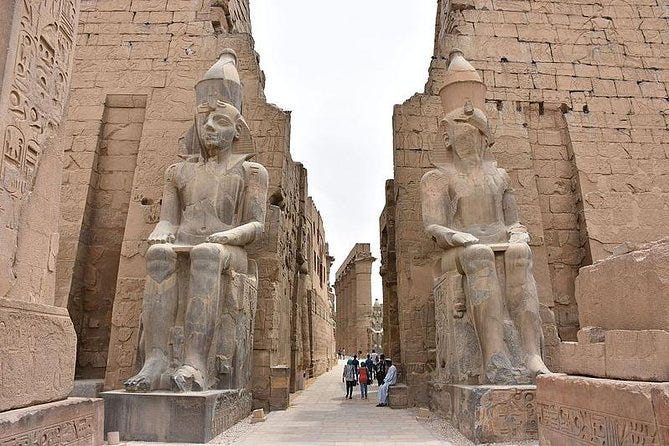
- Schwaller de Lubicz, a French mathematician measured and mapped the Temple at Luxor, Egypt. The temple incorporates Sacred Geometry and has human body proportions. Some suggest the Temple is a mirror or facsimile of the cosmic grand design as being fashioned as a ‘body’. The Temple corresponds to the terrestrial coordinates in terms of latitudes & longitude. Schwaller postulated the concept that ‘Man’ as a being is at the center of the Universe. The Luxor Temple is a physical expression of this correspondence known as the ‘Anthropo-Cosmos Man’. The Temple of Luxor describes the structure of the human body, incorporating its energy centers, or the Chakras. For example, the Temple correlates to the Earth’s equator both horizontally and vertically with the Energy and Vortices Grids Theories.
- The Temple’s geometry is based on human proportions. Some suggest that as the Earth is as a ‘body’ in form, so is the Cosmos. The proportions of the human body can be found embodied likewise in the Earth’s geometry of the temple’s proportions (Golden Ratio). The Luxor temple is, among other things, a symbolic representation of both the human Body and Earth’s circuitry that is affected by Energy Point (Chakras) & Energy Vortices locations. The Temple of Man is a perfect example of how ancient architecture was used as a symbolic representation of the physical body being projected beyond the physical realm.
THE EARTH-ANTHROPOMORPHIC MAN
- Earth is indeed a living organism with energy and life as the Human Body has. Like Earth, the human body is made up of 70% water. The Body has neuron and electric circuitry from the Brain, Stem/Spinal Column with corresponding pressure points. The Energy Grid Theory along with the Vortices Theory stipulate that likewise planet Earth conducts currents of Energy and has Pressure Points as in Chakras. The Golden Ratio thus lends credence to having both ends of the body as Earth’s Hemispheres be a complete and closed circuit of energy related to magnetism that can be and is affected by internal and external variables.
EARTH’s ENERGY GRIDS
- The Theory states that there are Energy Vortices at certain locations around the globe. There are said to be 12 geometrically distributed geographic areas that are alleged to have the same mysterious qualities popularly associated with that of the Bermuda Triangle, the Devil’s Sea near Japan, and the South Atlantic Anomaly etc. The Energy Vortices are considered to be ‘gates’ where time/space can bend or be altered, i.e., a door to a different dimension. This study and illustration takes from the research of the Vortices and Energy Grids Theory work of Rob- ert Coon and Becker-Hagens.
WHAT ARE CHAKRAS ?
- Chakra means ‘Wheel’ in Sanskrit or a ‘Circle’ as in a Vortex connected to a circuit. As the Earth rotates in such a fashion, it is affected by the Magnetic Sphere, Sun and Cosmic rays that emit certain ranges of Frequencies. So too the Human Body has corresponding circular focal or energy points. The concept is that ‘energies’ travel in certain frequen- cies through certain focal points in both the Earth as in the body. These points function as a reception to the transmission of the circuit energies that the human body picks up like a big antenna. Some suggest that these energy points correspond to frequencies made primarily of:
1) color 2) sound 3) light
4) energy
- Many cultures use this knowledge to heal the body and strive to reach a level of what they call ‘enlightened consciousness’. The 7 main chakras most recognized are described as being aligned in an ascending column from the base of the spine to the top of the head and beyond. As the human body has these ‘pressure point’s, so too does the Earth in term of tectonic pressure points that could affect the 188 Day cycle of earthquakes for example. The center Energy Point for the human body is the Heart area, where the Seat of the Soul is said to reside. With the superimposing of the Temple of Man with the Golden Ratio, a striking symmetry in the circuitry of where the Energy Vortices and Points on Earth are purported to exist correspond precisely to the human form.

THE PINEAL GLAND
- It is composed of silicon –as in a crystal.
- As such it func- tions much like an antenna receiver.
- Ancient cultures attributed this to the 3rd Eye that sees into the spiritual and Eternity.
What are Ley Lines?

- Alfred Watkins spoke about Ley Lines in his book The Old Straight Track, he realized that old monuments, burial grounds, religious structures, monoliths all ended up on a straight line. But this phenomenon was noticed in all cultures, during different time frames and manifested themselves in different ways.
- But apart from being a straight line that one can draw from the time of discovery in 1920, ley lines have something perhaps mystical about them. Ley lines have been associated with energy fields, UFOs, spirits, shamanic landscapes and more!
- Paul Devereux, the Author of Shamanism and the Mystery Lines: Ley Lines, Spirit Path has some interesting information on his site with regards to Ley lines and how they are intertwined with ancient Indian Spirit Lines and Shamanic Landscapes.
According to the author, “Hopewell Indians built geometrical earthworks covering many acres, along with straight linear features which seem to have been ceremonial roadways. In 1995, archaeologists announced the discovery of a 60-mile-long, dead straight Hopewell ritual road connecting earthworks at Newark with the Hopewell necropolis at Chillicothe.”

- What makes it even more interesting is grounds bearing Geoglyphs like the Nazca lines occurred where Shamanic tribes were present, mostly Shamanism based on hallucinogenic plants.
- An anthropologist Marlene Dobkin de Rios was the first one to notice this coincidence, noting that all these native hallucinogens promote the sensation of spirit flight, the “out-of-body experience” Dobkin de Rios felt that the mystery lines were associated with this aerial journey, the ecstatic centerpiece of the shamanic experience.
- The spirit lines of the Indians, which they used to transport the dead to the crematorium, and the shamanic landscapes all tend to use straight lines, it goes deeper than that, Ley lines have been used over forests, difficult landscapes where curved lines would have been easier to use. Another interesting thing is how some of the ley lines coincide with the earth grid, earlier mentioned as the Earth’s chakras.
- How the human body has seven major chakras, similarly, the earth has energy lines which some call ley lines and at certain points at equidistant around the earth they form energy vortexes.
What is an Energy Vortex?
- An energy vortex is a specific location on Earth which acts as a swirling center of energy, containing more earthly energy than any normal place would. One common belief in regard to energy vortexes is that they exist at the intersections of ley lines or the random lines of natural energy that make up the Earth’s electromagnetic field.
Where are Energy Vortexes Located?
- Energy vortexes can be found anywhere around the globe, from the American Southwest to the Great Pyramids of Egypt. Many energy vortex locations are ancient or sacred sites, like Stonehenge. Energy vortexes are still being discovered today because there is little scientific or mathematical ability to measure or discover these locations; instead, we must rely on our own and each other’s experiences to learn about what might be occurring in these places.
Why are Energy Vortexes Spiritual?
- Energy vortexes are believed to have powerful spiritual properties or be highly conducive to spiritual activities like prayer, meditation, and healing. Many vortexes are reported to bring feelings of peace, harmony, balance, and tranquility, while others are believed to promote personal reflection, deep insight, and a clear mind. Others still act as powerful centers of physical or emotional rejuvenation. Even ley lines themselves are believed to have spiritual significance. While there is no map of the Earth’s ley lines (as they, too, cannot be detected or measured), they might be traceable by connecting ancient or sacred sites to one another. One thing common to almost all energy vortexes is their ability to make visitors feel more connected to themselves and to something greater, whether that be God or the Universe itself — whatever you want to call it.
The Quantum Physics Behind Energy Vortexes and Their Spirituality

- First, quantum physics is the branch of physics which is concerned with the smallest units of our universe, atoms and subatomic particles.By studying subatomic particles, quantum physicists have observed that these particles are made up not only of substantive matter, but also of swirling vortexes of intangible energy. Therefore, everything in existence can be argued to also be made up of swirling vortexes of energy. (Interestingly, ancient spiritual masters taught that reality — everything we see — is not substantive, but an illusion.)
- If, on the subatomic level, everything contains non-substantive energy, it is probable that the Earth (which is also made up of subatomic energy particles) would be home to some kind of energy field. Perhaps certain geographical locations hold special amounts of energy, acting as major connecting points for this energy field.
Energy Vortexes: What Are They, Where Are They, and Why Are They Spiritual?
- First, quantum physics is the branch of physics which is concerned with the smallest units of our universe, atoms and subatomic particles.By studying subatomic particles, quantum physicists have observed that these particles are made up not only of substantive matter, but also of swirling vortexes of intangible energy. Therefore, everything in existence can be argued to also be made up of swirling vortexes of energy. (Interestingly, ancient spiritual masters taught that reality — everything we see — is not substantive, but an illusion.)
- If, on the subatomic level, everything contains non-substantive energy, it is probable that the Earth (which is also made up of subatomic energy particles) would be home to some kind of energy field. Perhaps certain geographical locations hold special amounts of energy, acting as major connecting points for this energy field.
- So if energy is much of what we are, does that mean that, as humans, we respond to the energy of our planet? It might make sense. Because we are made up of particles of energy, we might sense that same energy around us, especially in some specific places where it is greater or more intense than usual. That could explain the ability to feel a difference in our physical, emotional, and spiritual selves at geographical energy vortexes. After all, if we are just swirling bodies of energy, it would make sense that we would be receptive to otherswirling bodies of energy. Therefore, when we come in contact with unusually high amounts of energy — geographical energy vortexes — we can’t help but respond physically, emotionally, and spiritually.
- Furthermore, this dual nature of reality that quantum physics suggests — the idea that we are concrete yet non-substantive at our most minuscule levels — could speak to the existence of a power greater than ourselves. As complex and mind-boggling as all this is, it might be even harder to believe that a reality this intricate and fascinating could only be the work of a cosmic accident.
- Perhaps that is why energy vortexes have spiritual aspects to them: because humans as one energy creation are able to recognize and feel deeply in-tune with another energy creation. Maybe energy vortexes exist as a gift from a higher power to provide healing, clarity, peace and all those other beautiful things that are often so hard to find in our day-to-day world.
- All ancient cultures of the world understood this and no matter what they called it, it was just the spiral of energy that is not only within all of us, but the world around us. We are all beings that are powered by impulses and electrical charges made mostly of water and it only makes sense that swirls of magnetic energy, like the island of Es Vedra or volcanoes, or the Northern Lights will affect our very beings and literally draw us to them. Its not magic or witchery, its actually science and whether you believe in it or not, there are unseen forces that surround us everywhere on this planet. In a world where we can be so disconnected by technology, its a nice thought to think that there are places that exist, vortexes, that can give us renewed energy, disrupt our magnetic energy, and let us tap into the power grid of our planet.
- Just like the human body that has chakras or areas of swirled energy, so does our planet.
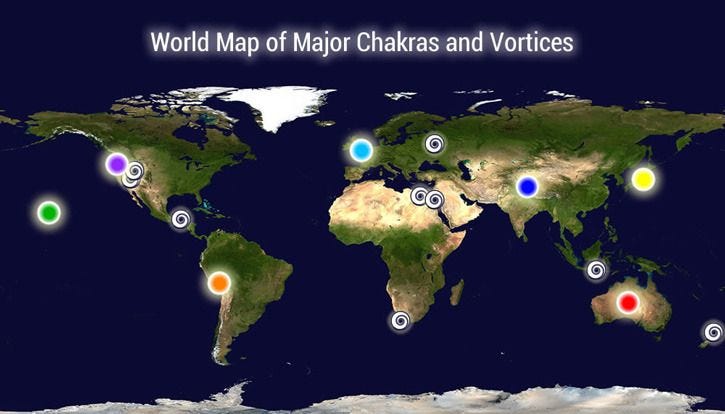
- There are many ways to wake up. And there are many things to wake up to. There are millions are points in our minds and bodies that can awaken. Science is revealing more about them on a biochemical level.
- On a spiritual level, however, there is ancient wisdom, with deep tradition, that considers 7 central points or portals of awakening — chakras. Many believe that these chakras mirror those of Earth. There are 7 physical places in our bodies and on our planet that are believed to be higher energy centers and that they are interconnected by a “rainbow serpent” of energy. They are places of exceptional beauty, where one cannot help but be moved.
- Whether it is only geology and weather, whether or not you subscribe to the spiritual construct of chakras, you will likely appreciate the beautiful views we are offering today. And whether or not you’ve ever been to any of them, they are places well worthy of a visit now.
- All of these places have been revered for thousands of years and ancient civilizations often built their megalithic sacred monuments in areas they considered “Earth’s Highest Energy Vortexes” or “Earth Chakras”. Structures like Stonehenge, the Pyramids of Egypt and Mayan, Aztec, and Incan monuments along with many temples, churches and pilgrimage sites are found in all of these powerful energetic spots. The idea of the “vortex” actually appears in all ancient civilizations. In fact, vortex literally means swirling spiral energy.
Energy vortex and power spots in the world
- The locations of energy vortex/vortices/power spots in the world have long fascinated followers of esoteric belief systems. A vortex is a special location on earth where energy is concentrated at a specific point. This energy can be either positive, leading to enhanced well-being and health or very negative and draining, causing poor health and mental stress. At these points on the earth, energy is either entering the earth or emanating out of the earth’s plane. There are several sacred sites on the earth that are believed to be energy vortices, for example the Egyptian Pyramids, Machu Picchu in Peru, Stonehenge in England, the Sedona desert in the US and Uluru in Australia. This swirling energy field moves up or down in a cone-like pattern and is thought to affect the people or animals in close proximity to it.
What is a vortex?
- An energy vortex is based on imaginary, energetic lines called “Ley Lines” that criss-cross the earth and intersect at certain points. The location of sacred sites across the world is thought to be interconnected by these lines. These points of intersection can be positive — spiralling in an upwards, clockwise direction or negative — spiralling downwards in an anti-clockwise direction. A positive vortex can be found when Ley Lines meet at a 90 degree angle — these sites are believed to promote good health and a peaceful mental state. In contrast, when a negative, imbalanced vortex occurs, lines are said to intersect in a less positive way. These negative energy lines are believed to be draining and able to cause poor mental, emotional, energetic, and physical health.
What does vortex energy feel like? Are they real?
- People who have visited sites where energy vortices are thought to be active have reported certain positive effects on the mind and body. These include physical, mental and emotional healing and resolution, feelings of peace and psychic abilities which are enhanced. A rush of energy or better clarity has also been noted. Some have written about tingling sensations in their body or a feeling of consciousness shifting. A sense of euphoria or more creativity is another way in which the locations seem to affect visitors.
Are they dangerous?
- Some report paranormal activity in the vicinity of the energy vortex. Negative energy vortexes are said to have negative feelings associated with them. Visitors to these areas report feeling tired, drained of inspiration, suffering headaches, ill health and depression or feelings of anxiety. The Bermuda Triangle and the Devil’s Sea are considered dangerous places where negative energy vortices are active and are feared by many people.
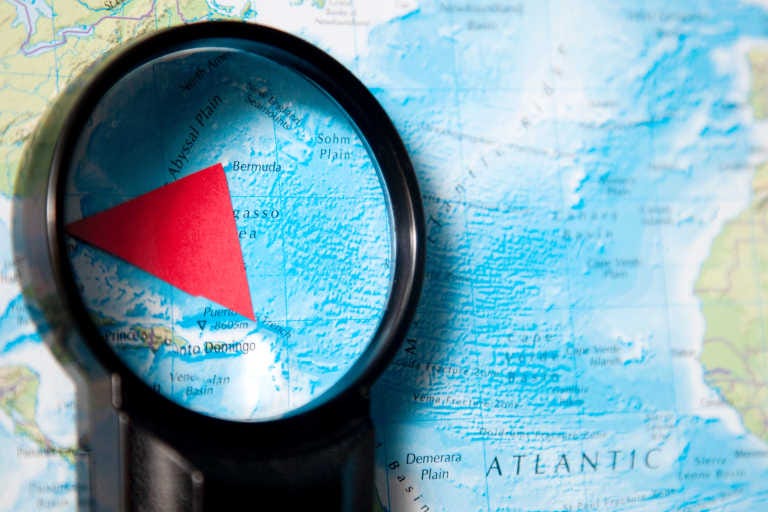
How and why does it exist?
- Energy or Ley Lines have been thought to exist since ancient times and places where they meet at a 90 degree angle have long been believed to be places of spiritual significance. It is believed that ancient cultures built sacred sites on these energy lines to connect them to the earth’s energy at these special points. They were believed to hold positive energy that could influence the well-being of communities. This idea is not, generally, accepted by the scientific community.
Where are some of the most popular spiritual places located?
- Sites include mountains, deserts, volcanoes, waterfalls, man-made structures and rock formations. The Great Pyramids in Egypt are probably one of the most well known sites considered to be situated on an energy vortex. Visitors to the structure have reported powerful spiritual awakenings. These structures were built using the mathematical constant of pi and have certainly fascinated people for centuries.
- The Himalayan mountains are the tallest range in the world and stretch across no less than five countries. They are believed to be sacred by the Hindus and Buddhists of the region. Mount Kailash in Tibet is called the seventh chakra of the world. One of the most revered sites in the world, Machu Pichu in Peru is thought to hold electromagnetic energy underground and is believed to encourage spiritual awakening and physical healing. Stonehenge is found in England and dates back to the bronze age where it was probably a holy site for Celtic priests called druids. Modern scholars believe it was most likely used as a burial ground.
- It may happen to be that some of the world’s popular destinations are also famous for being “power spots”.
ROOT CHAKRA: MOUNT SHASTA, CALIFORNIA
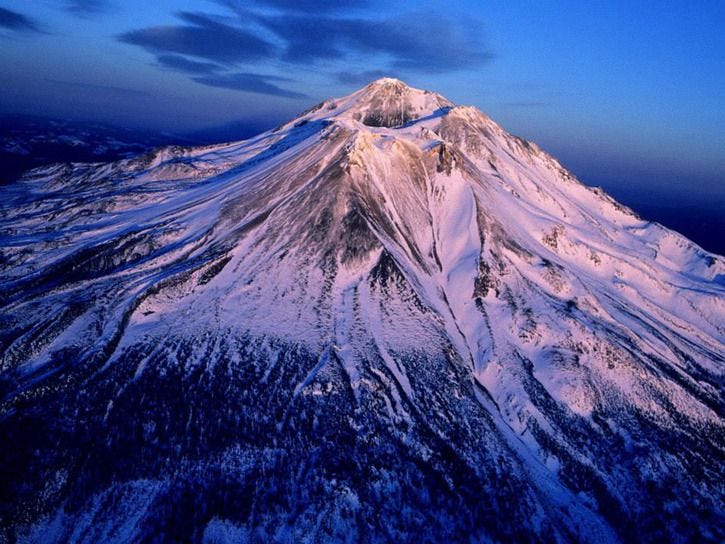
- Mt. Shasta is located at the southern end of the Cascade Range, which runs like a dragon from northern California, through Oregon, and through Washington to the Canadian border. There are many powerful mountains in this range, with Mt. Shasta and Mount Rainier — overlooking Seattle — the best known.
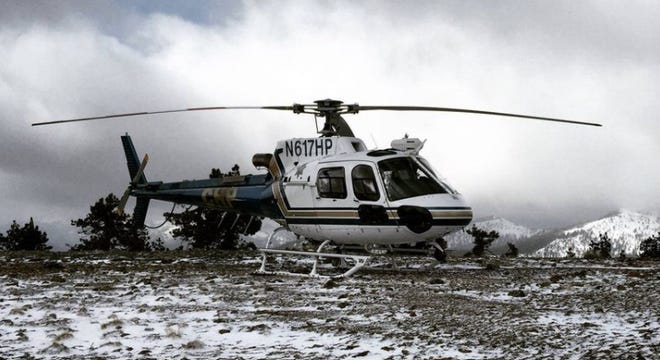
- Shasta is the most primal of the earth chakras. It is at the “base” of the world energy system. Here, the raw precursors of biological life are released into global circulation and development. Mt. Shasta regulates the universal life force prior to its integration into individual life forms and species. The energy of Shasta, as the first chakra, is like a geyser — a great uprush of life energy, or prana, without shape or structure.
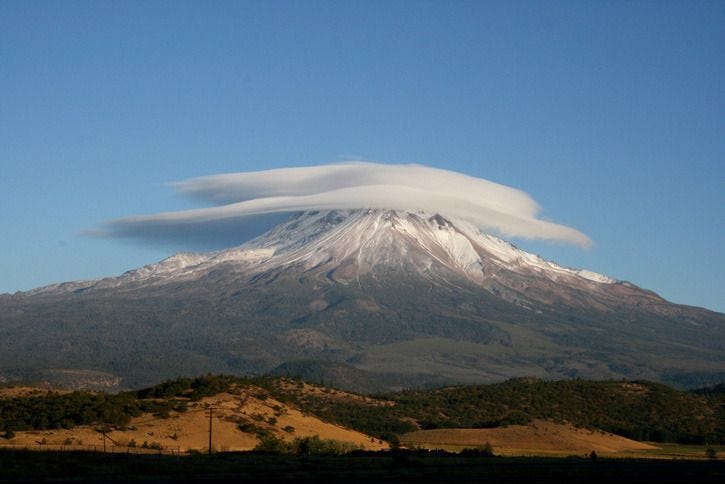
- There’s a lot of legend and mysticism surrounding Mount Shasta. The first inhabitants recorded date back as far as 7,000 years ago but it is thought to be inhabited long before that. Many believe this area to be part of old Lemuria, which is an ancient civilization older than Atlantis that was filled with superior human-like people that still live within the mountain in a series of elaborate caves. When Lemuria was on the verge of collapse, it is said that the elders petitioned inner Earth civilizations to help create a city underground for the inhabitants and Mt Shasta is one of the entrances.
- According to legend, JC Brown was British prospector who discovered a lost underground city beneath Mt. Shasta in 1904. Brown had been hired by The Lord Cowdray Mining Company of England to prospect for gold, and discovered a cave which sloped downward for 11 miles. In the cave, he found an underground village filled with gold, shields, and mummies, some being up to 10 feet tall.
- Thirty years later, he told his story to John C. Root who proceeded to gather an exploration team in. 80 people joined the team, but on the day the team was to set out, Brown did not show up. Brown was not heard from again.

- 60 miles south of the Oregon-California border sits the massive Mount Shasta, a 14,000 foot-tall active volcano and the second highest peak in the Cascades Mountain Range. Shasta has an interesting backstory: several Native American tribes have historically believed that the volcano could be the center of the Universe or even the birthplace of the Creator.
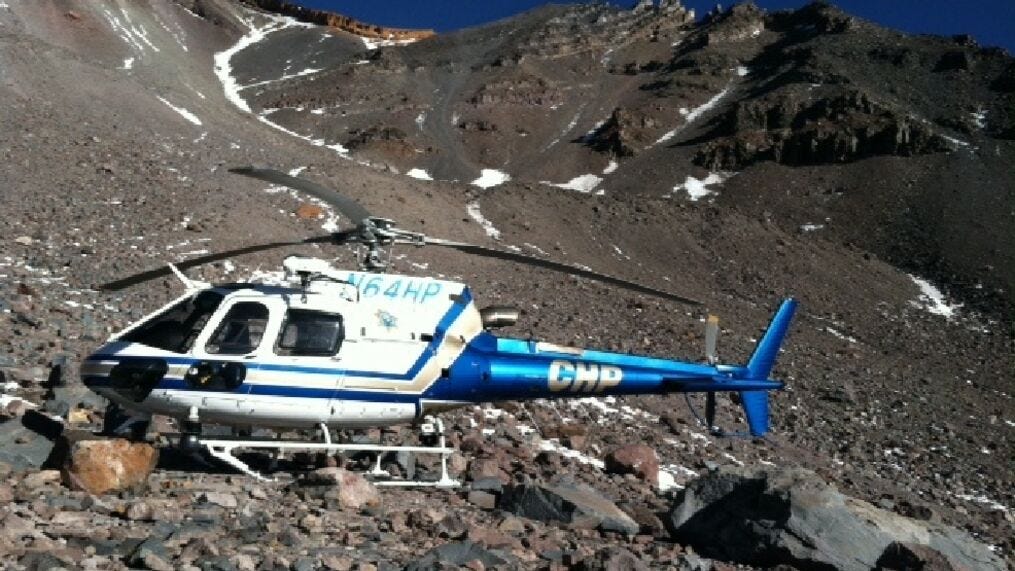
- Mount Shasta is also believed to be the root chakra of the Earth, and many look to its grounding, stable stature for a feeling of security. Many of Mount Shasta’s visitors are people seeking spiritual growth, transcendence, or healing; in fact, around half of the mountain’s visitors are those looking to experience the mountain’s energetic properties, often coming from all over the world to do so.
- In response to this new kind of tourism, New-Age-style shops have sprung up all around the town at the base of the mountain, nearby wellness centers offer natural healing methods, and countless spiritual retreats take place on the mountain throughout the year.
- Located in Siskiyou County in Northern California, Mount Shasta may not be as well-known for its energy vortexes as Sedona, but it is the second most well-known energy vortex in the United States. It’s also known as the Root Chakra of the Earth. The entire mountain is believed to be an energy vortex, and whether you’re on the mountain or in the nearby town of Mount Shasta, you can feel the healing energy and pull of this incredible location. You can feel the most energy by venturing up to the Bunny Flat or Panther Meadow trailheads. These are well-known gathering points for hikers, climbers, and those seeking spiritual experience in the vortex energy.
- The town of Mount Shasta has sprung up as a community of spiritual seekers and sages who have come to enjoy the spiritually powerful region, so it’s a lovely place to visit if you’re looking for spiritual healing and want to meet other like-minded individuals. You may also see a UFO, since the mountain is rumored to be a hotbed of UFO activity.

- Mount Shasta is a snowy (and still active) volcano located 60 miles south of the Oregon-California state line. The mountain rises out of meadows, forests, and flatlands, reaching more than 14,000 feet high. Shasta sees more than 25,000 visitors each year.
- Many of Mount Shasta’s visitors are people seeking spiritual growth, transcendence, or healing. Because of its powerful energy, Native Americans tribes have long told stories about the volcano being the center of the Universe or even the birthplace of the Creator. Some Native Americans still hold important ceremonies there today. Similarly, spiritual seekers visit the mountain to experience its power and peace for themselves.
SACRAL CHAKRA: LAKE TITICACA, BOLIVIA & PERU
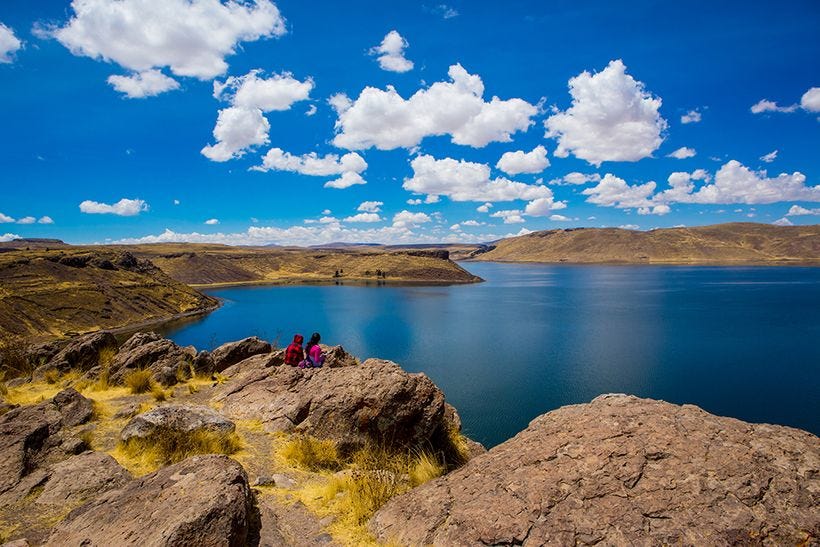
- The 2nd Chakra on this planet is located at Lake Titicaca. To be more specific it’s centre is located on the Island of the Sun where the Titicaca Stone is found. The lake itself is located in the high plateau of Collao in the Southern highlands of Peru, in the border with Bolivia.

- These territories were inhabited by cultures before the Incas, especially by the Tiahuanaco (100–700 AD), later, when this kingdom was destroyed, its people went to the North and then, its descendents founded the Inca kingdom. Finally, the Incas conquered these territories and considered the lake as a sacred place.
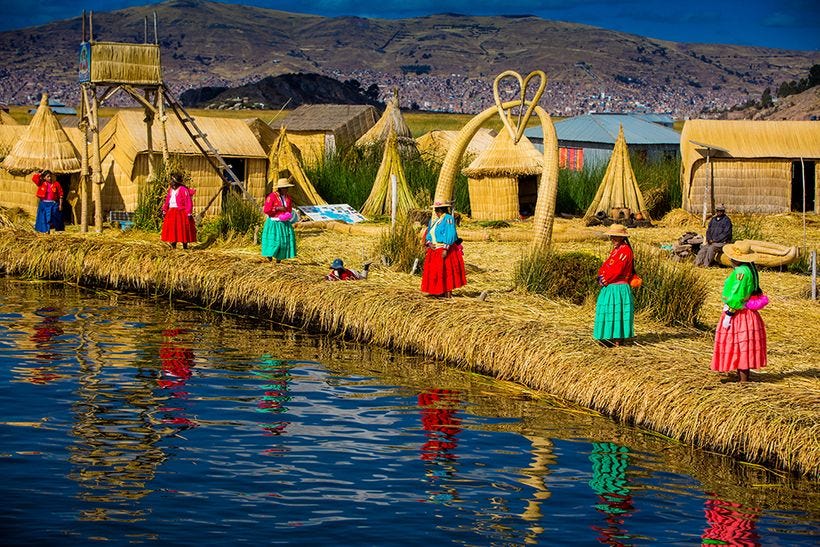
- In the 1970’s with Jacques Cousteau and then again in 2000, an international archaeological expedition discovered an ancient temple submerged in the depths of Lake Titicaca dating back before human history as we know it began. The huge structure is nearly twice the size of a soccer field (660 feet long), and was found by following a submerged road that begins near Copacabana. The temple is estimated to be between 1,000 and 1,500 years old. The Bolivian government has pledged to provide funds for further study of the ruins, and the eventual plan is to bring the temple to the surface. However, locals are fearful about the effects that such disrespect of the sacred lake might bring.
SOLAR PLEXUS CHAKRA: ULURU & KATA TJUTA, AUSTRALIA
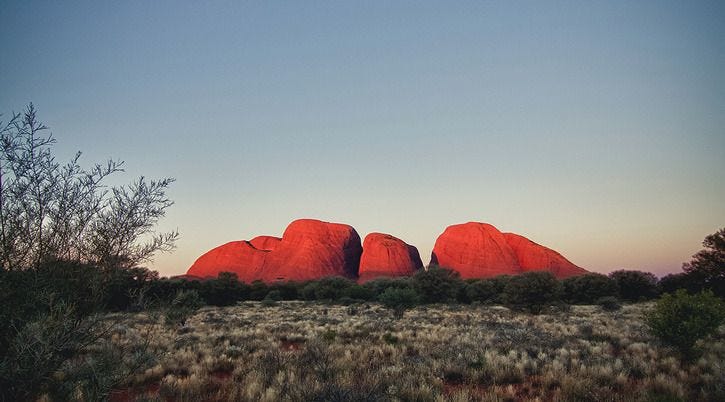
- Two massive rock structures in central Australia, Uluru (Ayers Rock) and Kata Tjuta (The Olgas), in Australia’s Northern Territory, are the centers of the Earth’s solar plexus chakra.
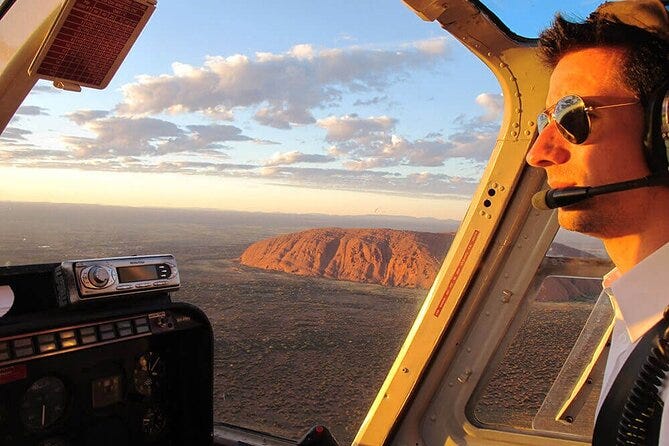
- They are said to represent the emotional solar plexus, considered the “umbilical cord” supplying energy to all living things.

- Uluru, formerly known as Ayers Rock, is the more famous of the two. This large red monolith is, along with the Sydney Opera House, an icon of the smallest continent. Katatjuta, also called The Olgas, is equally impressive. Rather than one monolith, this site consists of a large number of massive red stones.The global function of this chakra is to maintain the vitality of the Earth, and all living species.
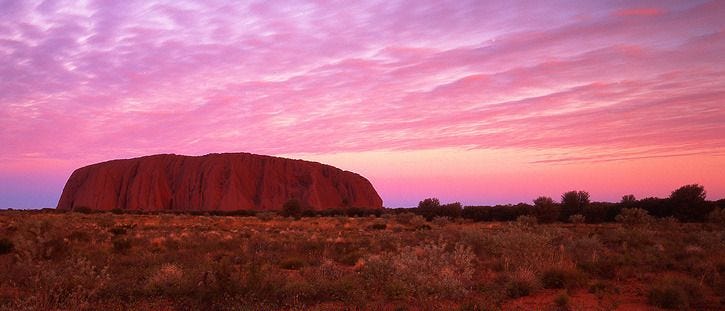
- In the ancient creation legends of the Aborigines, “Dreamtime”, there is a story about a great ritual which has yet to be completed at Uluru. This ritual was meant to complete the great plan of the earth spirit. When the ritual is complete, then perfection will spread throughout the world, and death will disappear from all species. This event is symbolized by a great pole, or cosmic umbilical cord, which is destined to unite the Sun with the Earth — heaven with earth. It is predicted that this cord begins to function in 2020 AD, at the time of the rare Saturn-Pluto conjunction.
HEART CHAKRA: GLASTONBURY & SHAFTESBURY, ENGLAND

- Glastonbury, Somerset and Shaftesbury, Dorset define the centre of the world’s heart chakra. In order for the force of greater life to be directed to maximum effect, the Grail of Immortality must be permeated by the Wand of the True Will. Glastonbury is the home of the Holy Grail; and Shaftesbury is the high place of the Sacred Spear of Purpose. When the earth energies of Glastonbury unite with those of Shaftesbury, then the Rainbow Serpent ley artery is able to deliver the immortalizing frequencies of the Holy Grail to all beings worldwide.

- It was said during Medieval times that if the Abbot of Glastonbury married the Abbess of Shaftesbury, then their children would be wealthier than the King of England. This is an alchemical riddle. If you unite the archetypes of the two areas, then love is united with will in a way that is revolutionary. For those who study the Cabala, this alchemical formula unites Binah (Grail) with Chokmah (Wand). The Grail, directed by the Will of the Earth spirit, has the power to dissolve all boundaries between nations. If the heart of the Earth expands to its full circle, then — throughout the world — pain, suffering, and physical death among all species will fade from experience and memory.
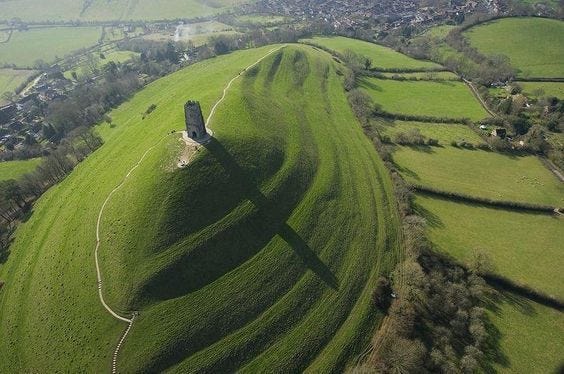
- The most famous legend of Glastonbury tells the story of Joseph of Arimathea and the Holy Grail. After the Resurrection of Jesus, Joseph shifted the archetype of Everlasting Life — the Grail — from Jerusalem to Glastonbury.

- The town of Glastonbury in southwestern England is home to several ancient and medieval sites. These sites include Glastonbury Tor, a tower on a hill which is tied to the legends of King Arthur, and the ruins of Glastonbury Abbey, a monastery completed in the early 8th century.
- Glastonbury is spiritual in that it is said to be where two highways of energy meet, connecting in three different locations throughout the town. These meeting spots give off a strong sense of peace and balance. Interestingly enough, as you move from the first vortex to the middle vortex to the final vortex, the feeling of energy is said to move upward in your body from your stomach to your heart to your head.
- These sites include Glastonbury Tor, a tower on a hill which is tied to the legends of King Arthur, and the ruins of Glastonbury Abbey, a monastery completed in the early 8th century.
- In England, the town of Glastonbury is believed to be the intersection between two large energy streams, creating an energy vortex. You’ll find two energy vortexes here at the Glastonbury Abby ruins and at Glastonbury Tor.
- Druids recognized the sacredness of the energy of this place, using the Glastonbury Tor, a unique naturally beveled hill in the middle of a field with the roofless St. Michael’s Tower at its peak, as the site of sacred initiations for priests and priestesses in around 2500 BCE. Glastonbury Abbey served as a monastery, and even before that, it is believed the area was a site of religious importance for ancient Celts.
- Due to the special energy of this place, many seekers make a spiritual pilgrimage to Glastonbury to experience its vibe. Along with vortex energy, you’ll also find this is the home of the first Christian Church in the British Aisles, and the area is alive with the lore of King Arthur.
THROAT CHAKRA: GREAT PYRAMID OF GIZA & MT. SINAI, EGYPT, MT. OF OLIVES, JERUSALEM, ISRAEL

- The 5th chakra is the throat chakra and is popularly believed to be the Great Pyramid of Giza and Mount Sinai in Egypt. They are said to be the Voice of our planet, the throat chakra, governing our communication of thoughts and feelings. It is how we express our inner creativity. The nearby Middle East is also often sited as the chakra location, usually the Mount of Olives or Mount Sinai.

- The Great Pyramid of Giza, also called the Pyramid of Khufu and the Pyramid of Cheops, is the oldest and largest of the three pyramids in the Giza Necropolis. Originally, the Great Pyramid was covered by casing stones that formed a smooth outer surface; what is seen today is the underlying core structure. Some of the casing stones that once covered the structure can still be seen around the base. At its heart are two rooms known as the King’s Chamber and the Queen’s Chamber.
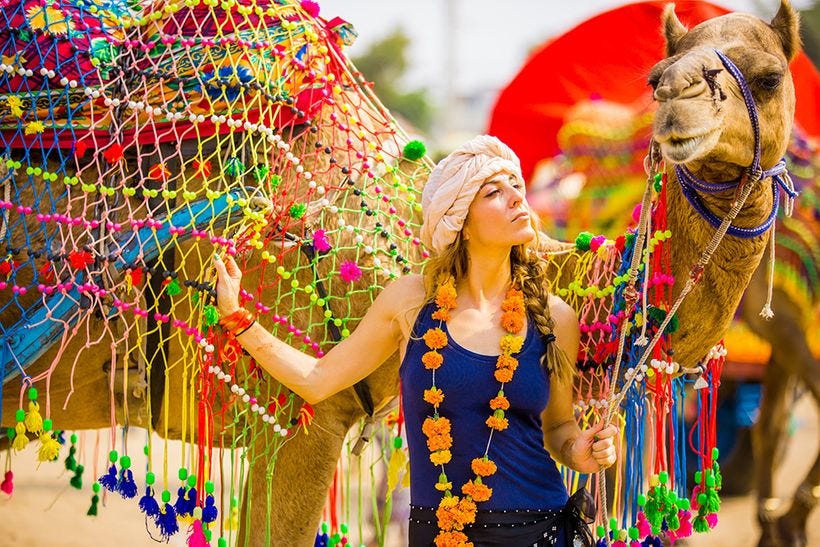
- The Great Pyramid is thirty times larger than the Empire State Building, the Pyramid’s features are so large they can be seen from the Moon. Its base covers 13.6 acres, each side being greater than five acres in area. A highway lane eight feet wide and four inches thick could be built from San Francisco to New York and put inside the Great Pyramid. The oldest structure in existence, having been started over 4,600 years ago, it is the sole remnant of the Seven Wonders of the World.

- The Great Pyramid of Giza, one of the Seven Wonders of the Ancient World, is the oldest and largest of the three Egyptian pyramids residing outside El Giza, Egypt. The pyramids were constructed approximately between 2550 and 2490 B.C., when Egypt was one of the greatest powers in the world.when Egypt was one of the greatest powers in the world. Each massive limestone pyramid was built by a different pharaoh to become his own tomb.
- Physicists have found that the Pyramid concentrates electromagnetic energy inside its chambers, which might confirm scientifically that the Pyramid is an energy vortex. Journalists claim that the Pyramid’s energy-bearing properties are likely a coincidence and that the builders (more than 4,000 years ago) probably had no idea; however, it is intriguing to consider the opposite. Perhaps the ancient Egyptians designated this location or used this building material for the pyramids because they could feel the energy there.
- Known for unique energies and spiritual awakenings by visitors, these are the most famous of the Egyptian pyramids. No one truly knows the original purpose of these mighty structures, but they were built using the universal mathematical constant of pi. In fact, many claim that these Golden Ratio buildings demonstrate a very important purpose. Many people believe that the pyramid form, when built using these specific mathematical equations, will aid in healings.
THIRD EYE CHAKRA: THE AEON ACTIVATION CENTER

- The third eye chakra moves westwards 1/12 of the way around the planet at the dawn of every new age. Sources locate the chakra in two different places, one shows it stacked with the heart chakra at Glastonbury and Shaftesbury in England, where you will find crop circles. Another shows it at Kuh-e Malek Siah, at the triple border of Iran, Afghanistan, and Pakistan. One, of course, is easier to visit than the other right now.
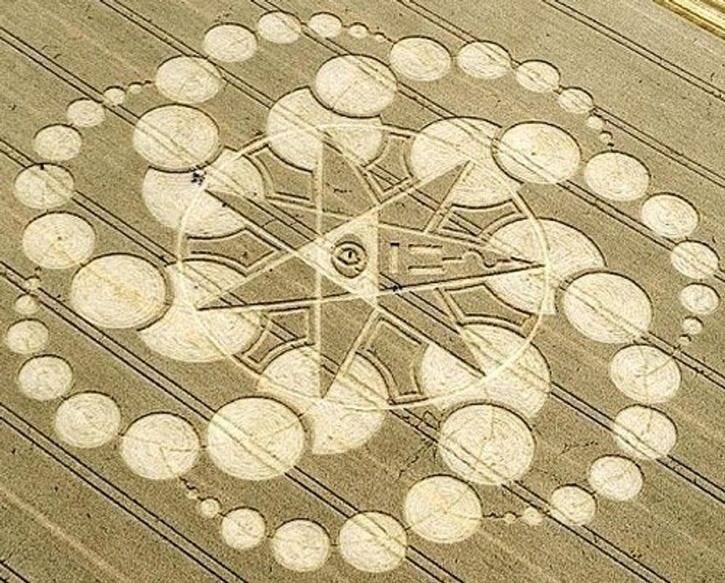
- The 6th Chakra is located on the human body between the eyes. This is why it’s also called the “Third Eye Chakra”. The 6th chakra’s energy resonates with clear thinking and clear vision. Nurturing this center allows us to integrate our intelligence with our intuition and end our fear of knowing the truth. This energy center is also connected to your focus, to your will, personal power, and ambition.
CROWN CHAKRA: KAILASH, TIBET
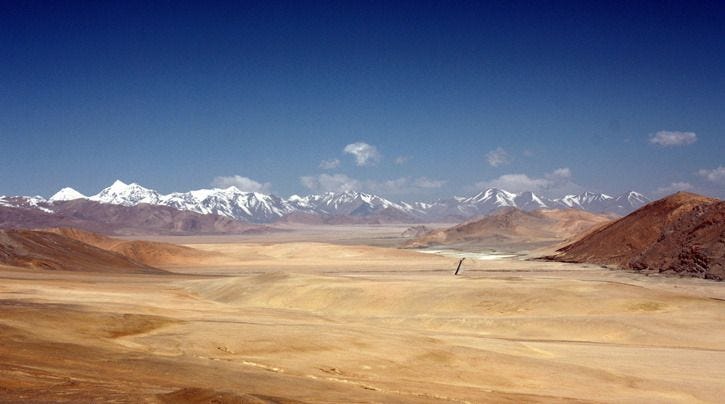
- The crown chakra is believed to enable our connection to our Higher Power — a gateway to the Divine. Located high in the mountains of Tibet, Mount Kailash is at the “crown” of Earth — in a perfect position to communicate with the entire Universe and all its inhabitants. Kailash is the most sacred mountain in the Himalayas, and is Located in Tibet rising to to 22,028 feet in one of the highest and most rugged parts of the Himalayas.

- There are two lakes are situated at the base of the mountain. The higher lake, Manasarovar, is round like the sun, and a lower lake, Rakshastal is the shape of the crescent moon. It is forbidden to even climb the mountain and there are no known reports of it ever happening despite the efforts of many. The indigenous people believe it to be so sacred that an attempt to climb the mountain would be considered a slight to the immortals and would inevitably result in death.

- Mt Kailash is the center for the annual Scorpio full moon event, in April or May. For the Earth, and for all immortals, this moon marks the new year, in terms of global evolution. It’s is important to for a spiritual visitor to this mountain to give attention to this annual full moon. There is a 90 minute period leading up to the exact culmination time of the Scorpio full moon. It is at this time that a person can find clarity in their life. The design and details of one’s own work can be clarified through this event.
POLAR VORTEXES IN THE NORTH AND SOUTH POLES
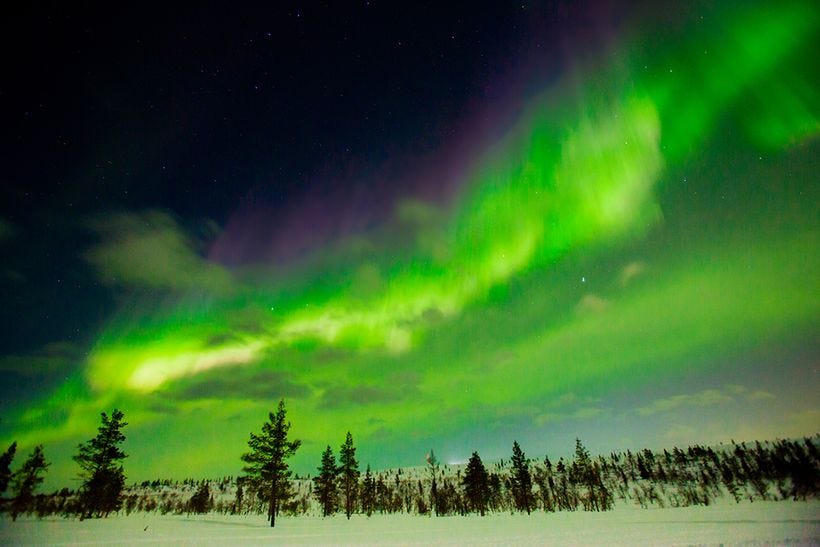
- The Saami people, the native reindeer herders who live in Lapland (which is the name for the area north of the Arctic Circle in Northern Finland, Sweden, and Norway) traditionally believed that the lights were the energies of the souls of the departed. Even to the native Saami people who have grown up for centuries seeing these “magical” lights, known as the Northern lights or the Aurora Borealis, they have remained a mysterious enigma or elusive phantom.

- Imagine the Earth as a giant, spherical, spinning magnet. Our core is one giant electromagnet that creates the polarity of the North and South poles. We literally have a protective force field around our planet with magnetic field lines that lead to the poles. It’s like those magnetic lines are the strings of an instrument and when plucked, the vibrations travel and collect at the poles.
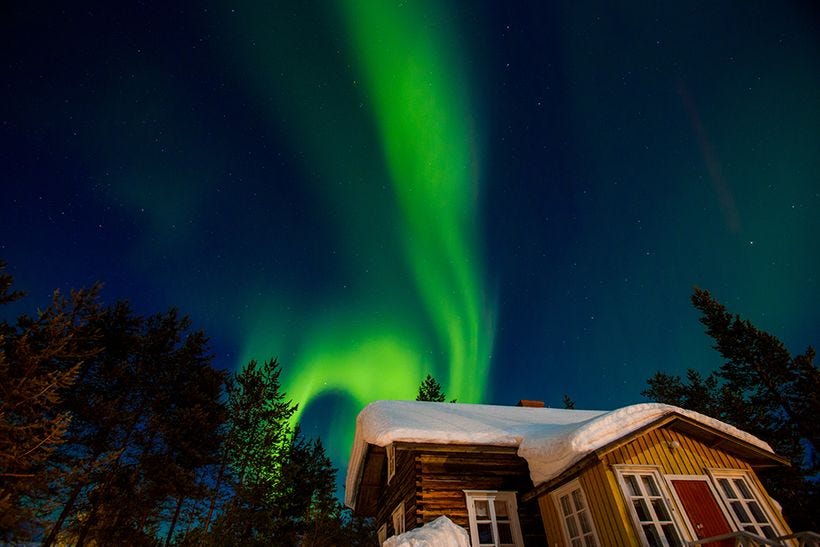
- Then we have our sun, which is a giant sphere of burning gas and energy that has huge explosions all of the time, ejecting super charged radioactive particles called solar flares shooting out towards our Earth. This event is called a solar storm and our electromagnetic force field protects us from these storms all of the time, but sometimes they can knock out power and interfere with GPS and radio communications. This sounds negative, but this “interference” is what we are searching for.
- The Northern Lights are just the solar particles hitting our magnetic field and causing a disturbance. These electrons and protons flow along the Earth’s magnetic field lines, the “strings” I mentioned earlier, and collect in energy vortexes at the poles. This is why you have to travel north of the Arctic circle or to Antarctica to be able to have a better chance of seeing them.
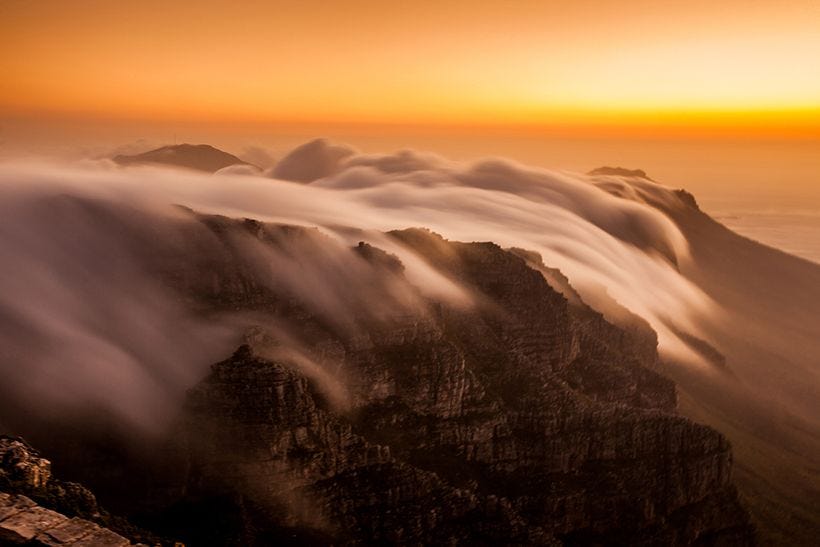
MACHU PICCHU, PERU

- An electromagnetic subterranean energy is said to reside in the Inca Citadel of this famous mountain. Machu Picchu is one of Peru’s most popular tourist destinations. This Inca ruin is said to be responsible for many healings and spiritual awakenings. In fact, the entire region is known for ancient mysticism that’s still prevalent today.
- Many visitors to Machu Picchu claim they can feel its powerful energy, making it a popular destination for spiritual seekers. One of the most powerful energetic features in this vortex is the Sacred Rock of Machu Picchu, and many place their hands on it to internalize its vibration.
- An electromagnetic subterranean energy is said to reside in the Inca Citadel of this famous mountain. Machu Picchu is one of Peru’s most popular tourist destinations. This Inca ruin is said to be responsible for many healings and spiritual awakenings. In fact, the entire region is known for ancient mysticism that’s still prevalent today.
- Many visitors to Machu Picchu claim they can feel its powerful energy, making it a popular destination for spiritual seekers. One of the most powerful energetic features in this vortex is the Sacred Rock of Machu Picchu, and many place their hands on it to internalize its vibration.
UBUD, BALI

- If you’ve heard of the town of Ubud before, it’s likely because of Eat, Pray, Love, the famous book and movie whose protagonist travels to Bali and spends time in Ubud. There, she learns a great deal from a spiritual healer named Ketut, an experience which helps to completely transform her life.

- Today, Ubud still retains that same sense of spirituality. The town has a little bit of it all: yoga galore, Balinese temples scattered throughout the serene rice paddies, vegan food, lush landscapes, and more. There is a reason why so many expats and digital nomads make Ubud their home base! One spot worth visiting is Goa Gajah, or “The Elephant Cave,” a carved cave and temple. Others include Gunung Kawi Sebatu, a very beautiful and less visited water temple (can get it to yourself!) and the Ubud Water Palace pictured above. Also consider paying a visit to the sacred water of Tirta Empul (translates to “Holy Water Spring”, often called “the Holy Water Temple”).

- Meanwhile, Ubud offers too many yoga retreats to count, with at least one that fits every niche. The island also hosts an annual BaliSpirit Festival each spring. The festival centers around yoga, meditation, dance, breathwork, sound healing, music, and personal growth.
- A visitor to Ubud could easily spend an entire trip simply enjoying the raw vegan cuisine there. In fact, a large part of Balinese cuisine is made up of vegan foods. In perfect Balinese fashion, the traditional way of preparing food involves a prayer and a blessing over the meal, so even eating can be a spiritual experience in Ubud.
- The biggest downside to Ubud, and Bali in general, is the overtourism. Word has gotten out about Bali and now traffic jams are common. It’s not a favorite spiritual spot for this reason.
SRITHANU, THAILAND

- Srithanu, Thailand is a small village and fishing port on the west side of Koh Phangan Island, off of the southeast coast of the mainland. The island is famous for its monthly “Full Moon Parties,” which draw large crowds of foreign visitors to its party scene. However, the area also has a spiritual side: legend has it that Koh Phangan sits atop a mound of quartz crystals which give the island its unique spiritual and healing properties. The origins of this legend are unknown, but the story is embraced by a local community which tends to care deeply about health and transformation.

- Srithanu is often described as being “the spiritual hub of the island” and having a “New Age mentality,” as it is very spiritually focused and health-conscious. The village is full of yoga schools and teachers, vegan and vegetarian foods, and holistic practitioners. You’ll also find a beautiful stretch of sandy beach. In the evenings, hang out at one of Srithanu’s calm cafes or restaurants to hear some live drumming or singing.\

- Countless yoga retreats take place in Srithanu and Koh Phangan in general. Some include meditation, others include spa treatments, and still others include outdoor activities like stand-up paddle boarding. There are so many to choose from that there is bound to be one for everyone.
GOA, INDIA

- Goa, India’s smallest state (in area), lies approximately 300 miles south of Mumbai on the country’s western coast. The state displays a distinct blend of styles, as it was a Portuguese colony for 450 years; today, both Catholic cathedrals and Hindu temples are scattered throughout the city. Frequent religious festivals and ceremonies from a number of faiths make for a spiritual atmosphere.

- Pay a visit to the baroque Basilica of Bom Jesus pictured above, as well as the old Mahadeva Temple, the red and orange Maruti Temple, and riverside Shri Damodar Temple.

- Yoga and meditation are enormously important in India. Yoga is a core practice of the Hindu faith, while meditation is equally valued because of its close ties to Buddhism. Goa is a popular location for yoga and meditation retreats, and with plenty to choose from, they vary in length, price, and style.
TULUM, MEXICO


- Tulum being the location of an energy vortex, which already hints at its spiritual nature. It is believed that the asteroid, which wiped out the dinosaurs, hit the Earth at the Yucatan peninsula, on which modern-day Tulum sits. It sits 80 miles south of Cancun, and ever since, the area has possessed a special kind of energy. During the early 1200s, the Mayan people chose Tulum as a location on which they would build temples and a sprawling city, and now the ruins of this city attract visitors from all over the world.

- Mayan spirituality has left a lasting influence on the area, too. For one thing, the ruins of their temples signify the place where they once worshipped gods and goddesses. They also recognized cenotes, natural freshwater pools found throughout the region, as spiritual centers.
- Today, Tulum has grown to become a major epicenter for spiritual visitors. Not only are there countless yoga and mediation studios scattered all over town, the resorts that have sprung up in recent years host yoga retreats of all different kinds. Local spas work with the natural energetic properties of the area to promote healing, and many offer the chance to participate in the ancient purification ritual of Temazcal, in which a steam bath connects participants to the earth and cleanses the mind, body, and spirit.
- Mayan Ruins, Tulum, Mexico — The ruins of the Mayan city of Tulum, overlooking the Caribbean, are awe-inspiring. The city was constructed on the Yucatan Peninsula, about 80 miles south of Cancun, during the late 13th century. Tulum was once a major sea port for the Mayan Kingdom, acting as a hub for trading jade and turquoise.
- Scientists believe that the asteroid that hit the earth and wiped out the dinosaurs 66 million years ago actually landed at present-day Tulum, giving the area a powerful energy. Many nearby resorts offer spa treatments that work in tandem with the naturally energetic properties of the area to promote physical and emotional healing.
- While the complexity of the energy vortex phenomenon is a bit difficult to understand and to prove, there is some scientific backing to it all. Quantum physics offers an explanation as to how all this is really possible. In fact, quantum physics might just go hand-in-hand with spirituality.
- On Mexico’s Yucatán Peninsula, you’ll find the Mayan ruins at Tulum. The walled city of Tulum is located on 39-foot cliffs overlooking the Caribbean Sea on the Yucatán Peninsula’s east coast, and it’s one of the last cities inhabited by the Maya people. Many believe these ruins are imbued with deep spiritual resonance arising both from the location and from the mystical energy of the Mayans who once inhabited the city. It is also believed that the high vibrational area of this region was caused by a meteor impact. Whether you visit for spiritual awakening or eco tourism, you’ll feel the vibration of this powerful vortex.
IBIZA, SPAIN


- Another energy vortex location, Ibiza is home to Es Vedrà, a massive limestone rock jutting out of the ocean just off the coast of the island. This isn’t just any rock, though: legend has it that Es Vedrà is the tip of the sunken city of Atlantis.
- There are many claims that this rock has a strong magnetic field, one which falls into the same category as the North Pole and the Bermuda Triangle. The limestone of Es Vedrà is the same as that found in the Mayan ruins in Tulum, as well as in other powerful energy spots like the Egyptian Pyramids and Stonehenge. This limestone is believed to hold the maximum possible concentration of energy. Many visitors to Ibiza have claimed that they felt a special kind of healing, inspiring, or meditative energy there.

- The island itself is home to countless healers and yogis, and many different yoga retreats draw visitors from all over the world. The House of Colors, a healing center which sits up in the hills of Ibiza, perfectly embodies the spiritual sense of the island as it aims to help visitors seek balance in their lives and connection with the world around them.
- Es Vedrà is a huge limestone rock jutting out of the Mediterranean Sea off the west coast of the Spanish island of Ibiza. It towers more than 1300 feet above the sea, and legend has it that the rock is the tip of the sunken city of Atlantis. The rock has a powerful magnetic field which leaves compasses spinning and even birds disoriented. (In fact, it has led to claims that Es Vedrà is the third most magnetic spot in the world, only behind the Bermuda Triangle and the magnetic North Pole.)
- Interestingly, Es Vedrà is made of limestone similar to that of other powerful and energetic spots like the Egyptian Pyramids, Stonehenge, and Mayan ruins in Tulum, Mexico. This limestone is believed to hold the maximum possible concentration of energy, which could explain why all four sites are considered to be energy vortexes. Visitors to the rock report having experienced healing, creative and inspiring energy, and powerful meditation.
STONEHENGE, WILTSHIRE, ENGLAND

- Stonehenge is one of the world’s most famous ancient sites, the start of its construction dating back nearly 5,000 years. The 100 upright stones arranged in a circular shape are thought to have been a burial site or ceremonial grounds.
- Stonehenge is supposed to be the meeting place of 14 ley lines, making it a powerful energy spot. Because it is believed that these lines can be located by connecting ancient spiritual sites like churches, an intersection of 14 of these lines at Stonehenge (which was erected before any of those other sites) is rather fascinating. It is also interesting that historians believe Stonehenge to have once been a burial site, thereby giving it even more spiritual significance.

- Sitting in the center of a convergence of 14 major ley lines, the ancient site of Stonehenge has long been believed to be an energy vortex. A prehistoric monument sits here. The monument’s purpose is the subject of legends and mystery, since no written records exist explaining why it is there or what it’s used for. Still, visitors here report feeling deeply spiritual energy that likely comes from the convergence of the ley lines that create this powerful energy vortex.
SEDONA, ARIZONA


- The Guardian called this red-rock town in Arizona, “America’s new-age capital,” and residents coined “a cathedral without walls”; still others have called it a “spiritual mecca.” So what is it about Sedona that is so special?
- For one thing, Sedona is the location of not just one, but four energy vortices which are believed to be points of strong electromagnetic earth energy. One of these vortices is the Chapel of the Holy Cross, a huge church built in 1956 which was once called, “a spiritual fortress so charged with God that it spurs man’s spirit God-ward.” The vortices have proven Sedona to be conducive to prayer, meditation, mind-body healing, and other spiritual activities, making the town a popular destination for rejuvenating retreats.

- We begin our Vortex Journey in Sedona, AZ with a 3-night stay at The Enchantment Resort, located in Boynton Canyon. The prehistoric waters, that once covered the Southwest, created red rock formations in Boynton Canyon, attracting those seeking places of natural beauty and rare energy.
- The dramatic red rocks will set the tone for an experience beyond compare. You will move and be moved through a unique and powerful connection with nature, exhilarating adventures and relaxation.
- Choose from many adventures such as mountain biking, hiking, canyon walks, tennis, pickleball, and yoga classes, all arranged to fit your thirst for adventure and excitement. We also have planned for you chakra balancing, mandalas and Zen art, mindfulness through breath presentation and vortex lectures. You will visit special vortex places around Sedona for meditation to open your hearts to receive all that is there for you.
- Sedona has been sacred ground for millennia. The energy resonating through its red rock landscape is unlike anything you’ll ever experience. Recharge during this completely customizable tour while learning about Sedona’s natural history and the Native American teachings related to the Medicine Wheel.
- Explore the natural wonders of Antelope Canyon, a narrow slot canyon carved by wind and water through the ages. A Navajo guide helps you photograph the shifting light and creamy colors of the sandstone canyon, a must-see amid the splendor of the American Southwest. Views of Glen Dam, Lake Powell, and Horseshoe Bend are included en route from Sedona.
- Our cuisine will be inspired by indigenous ingredients inspired the Native American Southwest, featuring seasonal dishes with innovative flavors.
- Shopping in Sedona is more than just a thing to do in Sedona; it’s actually an experience as well. Not only will shoppers find hand crafted clothing, antiques, furniture, collectibles and gifts abound at one-of-a-kind boutiques, there are aura readers, psychics and spiritual healing services behind the curtains of many of the crystal and vortex shops. With five major shopping districts in Sedona, you can start your Sedona shopping excursion in Uptown Sedona — Sedona’s most-popular shopping & dining district with an eclectic collection of shops along Main Street and clustered in open-air shopping plazas like The Shops at Pinon Pointe and Sinaqua Plaza — it’s souvenir central. Sedona shopping continues at three must-visit shopping destinations along Oak Creek and Highway 179: Tlaquepaque, Hillside Sedona, and Hozho Sedona. Be sure to check out West Sedona’s The Old Marketplace, and the Village of Oak Creek where you’ll find both Tequa Plaza and the Sedona Factory Outlets.
- Sedona is bursting with spas, wellness centers, healers, yoga instructors, and more. You’ll find everything from hiking to healing massage to hypnotherapy, with a whole lot in between. The town even hosts an annual Sedona Yoga Festival, with more than 200 classes, workshops, and events in yoga, sound healing, sacred music, meditation, and healthy eating. Regardless of your style, you’re bound to have a powerful spiritual experience in Sedona.
- Sedona is a popular destination for rejuvenating retreats thanks to the beauty of its natural red rock structures and an abundance of spas and wellness centers. Canyons and forests make up the landscape, making Sedona one of Arizona’s best destinations for hiking, biking, camping, and other outdoor activities.
- Sedona as a whole is considered an energy vortex, but four specific locations within it are said to be especially energy-charged due to the convergences of ley lines.
- Completed in 1956, the Chapel of the Holy Cross towers among the red rocks, with the huge cross on its face stretching high above the valley below. Marguerite Brunswig Staude, who had it built, called the church “a spiritual fortress so charged with God that it spurs man’s spirit God-ward.
- There is so much more to Sedona than meets the eye.
- Beneath the endless beauty beats a healing heart. Sedona has long been regarded as a place both sacred and powerful. It is a cathedral without walls. It is Stonehenge not yet assembled. People travel from all across the globe to experience the mysterious cosmic forces that are said to emanate from the red rocks. They come in search of the vortexes.
- What is a vortex? Sedona vortexes (the proper grammatical form ‘vortices’ is rarely used) are thought to be swirling centers of energy that are conducive to healing, meditation and self-exploration. These are places where the earth seems especially alive with energy. Many people feel inspired, recharged or uplifted after visiting a vortex.

- Although all of Sedona is considered to be a vortex, there are specific sites where the energy crackles most intensely. The four best known Sedona vortexes are found at Airport Mesa, Cathedral Rock, Bell Rock and Boynton Canyon — each radiating its own particular energy. Some are thought to produce energy flowing upward while at others the energy spirals downward, entering the earth.
- Don’t be surprised to find people doing meditation, yoga or performing other rituals at vortex sites. Please be respectful. There are several companies, individual guides and healing practitioners that offer vortex tours. But everyone is welcome to visit on their own. All vortex sites are easily accessible and maps and directions are available at the visitor center. Show up with an open mind and see what happens.

- Sedona has developed a worldwide reputation as a place of enlightenment. This is home to a large community that promotes a variety of alternative healing and spiritual practices. There are wellness shops and boutiques scattered through the town. In addition, many of Sedona’s spas offer Native American-inspired treatments using indigenous materials like red rock clay and local plants.
- Yet even if you have no particular interest in the metaphysical movement, plan on visiting Sedona’s vortex sites. It is virtually guaranteed that you will leave feeling better than when you arrived. Your heart will be lighter, your smile will be wider and you will feel more energized. Because here’s the wonderful secret: Vortexes are located at some of the most devastatingly scenic spots found among the towering red rock formations. Anytime you can get outside to walk in sunshine, breathing fresh clean air amid dazzling panoramas is a day well spent.

- Sedona has the ability to transform lives. That’s its true power. The raw physical beauty of the landscape automatically recalibrates your sense of wonder. Embrace the spectacular. Accept the astonishing. This is a place that inspires, recharges, uplifts, soothes, restores and so much more. For many, the very act of being here provokes a spiritual awakening. No one leaves Sedona unchanged.
- No matter what paths you take while traveling through life, Sedona is always the scenic route. That’s a journey well worth taking.
- Sedona, Arizona is a known spiritual hub of energy that attracts people from around the world. With towering red rock formations, Sedona is a popular destination for spiritual travelers seeking its powerful energy. Along with the vortex energy, you’ll find all kinds of spiritual activities from guided outdoor meditation retreats to metaphysical shopping. It’s also a great place for all types of outdoor recreation.
There are four major vortexes in the Sedona, Arizona area along with a few lesser known vortexes. These include:
- Bell Rock Vortex — This vortex is extremely powerful in its energy, and you can feel it if you’re anywhere near Bell Rock. There’s a hike and a climb involved, as well as two access points; however, the vortex is so strong that you don’t need to be on the rock to feel the energy.
- Boynton Canyon Vortex — It’s an easy hike to the Boynton Canyon Vortex, so it’s a good one to visit for vortex hunters in all levels of physical condition. Expect to walk about 1/2 mile from the parking lot.
- Cathedral Rock Vortex — The hike to the Cathedral Rock Vortex is challenging; you’ll only travel about 3/4 of a mile, but in that short distance you’ll climb about 650 feet. The vortex is in the saddle of the rock.
Additional vortexes in or around Sedona are located in the following places:
- Chapel of the Holy Cross
- Buddha Beach
- Oak Creek Canyon Overlook
- Energy Well Spring (Oak Creek Canyon)
HAWAII


- Anyone who has been to Hawaii would likely agree that the islands have a unique spiritual sense about them. Maybe it’s the warm, friendly attitude among locals, a reverence for the land, or the general feeling of slowing down and reconnecting which pervades the islands; regardless, Hawaii’s got something special.
- A strong sense of Hawaiian spirituality throughout history has led to the existence of countless spiritual sites around the islands today, each with its own story. Nearly every island has at least one specific spot which is important to the spiritual essence of Hawaii. Some noteworthy ones to visit include southeastern Maui’s Haleakalā Volcano, Molokai’s Hālawa Valley, the seven sacred spots of Kauai’s Wailua, and the Big Island’s Mauna Kea (the highest point in all of Hawaii).

- Today, a variety of yoga retreats can be found all over the islands. Surfing, too, plays a role in Hawaiian mindfulness and connection. Meanwhile, much of Hawaiian cuisine places an emphasis on fresh, natural foods like seafood and tropical fruits, so eating healthy on the islands in conjunction with your spiritual seeking is easy and enjoyable.
- Haleakalā Volcano, Hawaii, USA — Hawaii has no shortage of natural wonders, and southeastern Maui’s Haleakalā Volcano is certainly one of them. The volcano is also referred to as Haleakalā Crater because of the erosion which has eaten away at the top of the volcano over time. The views of the island from the top of the volcano are breathtaking, especially at sunrise.
- The volcano is not just home to incredible views, though; it also has a special energy. The top of Haleakalā gives off a frequency which matches that of the human heart. It allows visitors to feel Maui’s energy, one which is nurturing and motherly, giving it the name “Mother Maui.”
- Don’t forget to drive the Road to Hana when you visit, as well.
ANGKOR WAT, CAMBODIA

- Angkor Wat is not only the largest religious monument anywhere on Earth, it’s been nicknamed the “Seventh Wonder of the World.” This Cambodian temple complex was built in the early 12th century for the Hindu god Vishnu and was designed artistically as a miniature replica of the universe. Today, the temple is home to a number of Buddhist monks.
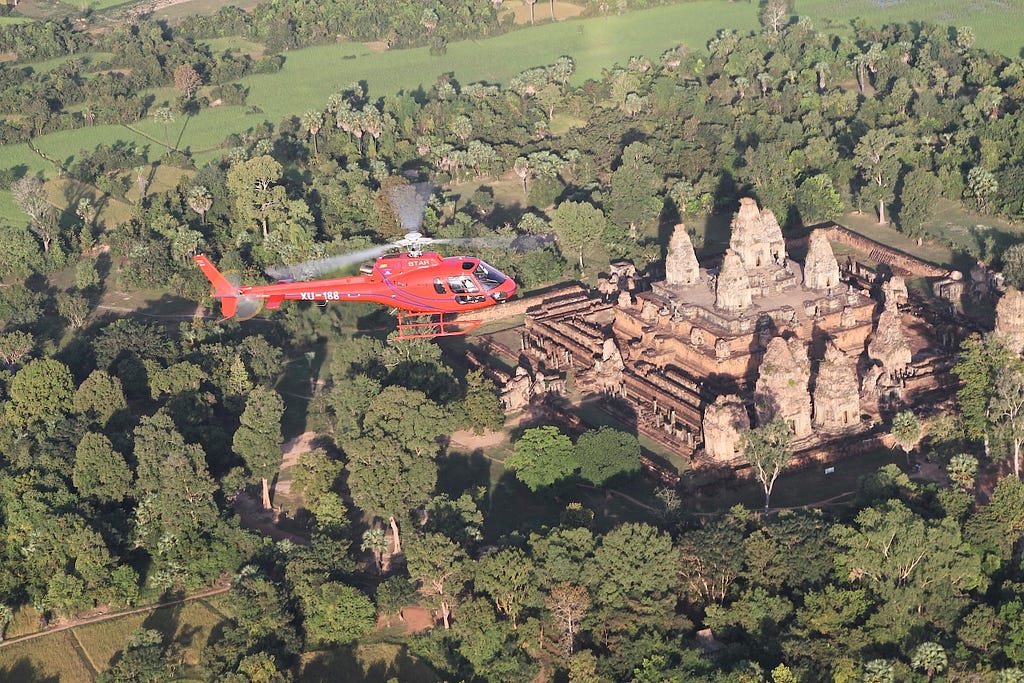
- There are several other temples surrounding Angkor Wat, as well, including Angkor Them, Bayon Temple, Ta Prohm, and Preah Khan. All this just goes to show that spirituality plays a major role here! The area also hosts countless yoga and meditation retreats, ranging anywhere from three to seven days. Healthy food is also widely available in the nearby town of Siem Reap, where Khmer cuisine is based largely on fresh, healthy ingredients like vegetables, fish, and herbs.
- A trip to Cambodia to see Angkor Wat and the surrounding temples, completing a yoga retreat, and enjoying some fresh, healthy food might be just what you need to have the perfect spiritual experience.
ADAM’s PEAK, SRI LANKA

- Standing at nearly 7,500 feet tall in the central highlands of Sri Lanka, Adam’s Peak is the country’s most famous mountain, and with good reason. A five-foot depression in the rock at the very top of the peak has deemed the mountain (which is also called Sri Pada, or “sacred footstep”) a holy location to four religions: Buddhists believe that it is a footprint from Buddha; Hindus think the footprint belongs to Shiva; Christians and Muslims think it marks Adam’s first step outside the Garden of Eden.

- The trek up the mountain — which consists of more than 5,000 crumbling stone steps — is beloved by both tourists and Sri Lankans, many of whom are Buddhist and consider Adam’s Peak a pilgrimage. From December to May each year, many complete the two-to four-hour climb in silence and reverence during the middle of the night so as to be at the top for sunrise. Once at the summit, groups busy themselves in prayer and meditation. It’s also possible to hike during the off-season, but bring your own light as the trail will not be illuminated.
- In nearby Sri Lankan areas, yoga and meditation retreats are common. Pair one with your trek up Adam’s Peak for an especially connective experience in Sri Lanka. Whole foods, too, play an important role in Sri Lanka, as fruits, vegetables, rice, and coconut make up a large part of the country’s cuisine. Take advantage of the healthy ingredients in Sri Lankan cooking to reconnect with the body and mind.
HIMALAYAS, ASIA
- The tallest mountain range in the world is famously known for the challenge of climbing Mount Everest. This Asian range stretches across five countries, including India, China (Tibetan Plateau), Bhutan, Nepal, and Pakistan. India, Bhutan and Nepal are recognized as the sovereigns of the mountain range. The Hindus and Buddhists revere the mountains as sacred, and spiritual sojourns to the Himalayan range are common. Mount Kailash (or Kailas) is located in Tibet and known as the seventh (crown) chakra of the world.

EASTER ISLAND, CHILE
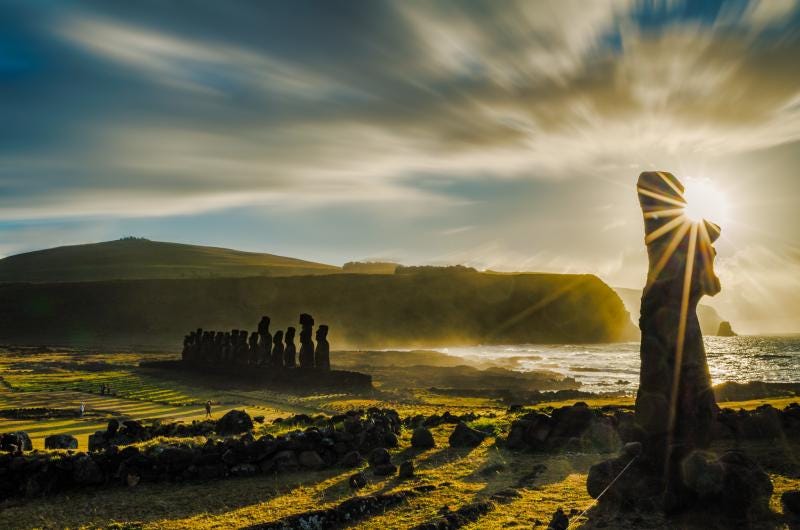
- This Pacific Island holds 887 carved humanlike statues that were recently discovered to be nearly twice the size as the portion exposed above ground. Easter Island is commonly believed to be within a large black spiral. The giant monolithic stone heads, called moai, are made from magnetic rock, which many believe is the source of the powerful energy on this remote island.
- While Easter Island is difficult to reach and remote, for those who visit for spiritual activities or outdoor adventures, you can have a high vibrational experience if you visit.
Other Energy Vortexes in North America
Many other locations are believed to be energy vortexes as well.
Crater Lake, Oregon
- A volcanic crater that has formed a natural lake, Crater Lake is a National Park located in South Central Oregon. It is a sacred site for the Klamath Tribe, as well as a popular tourist destination.
Denali National Park, Alaska
- Another in America’s National Park system, Denali gets its powerful vortex energy from the intersection of ley lines. Whether it’s the powerful energy of the breathtaking beauty, Denali has much to offer spiritual seekers.
Garden of the Gods, Colorado
- Located in Colorado Springs, Garden of the Gods is the location of spectacular red rock formations similar to those found in other vortex locations. This is also a sacred place for many Indigenous people including Ute, Shoshone, Apache, and Lakota.
Lake Louise, Alberta
- Located in Alberta, Canada, visitors to this beautiful location can feel its powerful vortex energy. Located in the Canadian Rockies in Banff National Park, you’ll not only get powerful vortex energy here, but you’ll also experience breathtaking scenery and the opportunity to enjoy the great outdoors.
Mount Mitchell, North Carolina
- Mountains are often the source of powerful vortex energy, probably from a combination of the minerals and rocks that make up the mountains and the topography of the land. The tallest of the Appalachian Mountains, Mount Mitchell is also a sacred place for the Cherokee people, who call it Attakulla. It’s located outside of Asheville, NC.
Ojai, California
- Located in a peaceful valley in Ventura County, north of Los Angeles, Ojai is well known for its calming vortex energy that visitors can’t help but notice. And whether you’re on a spiritual pilgrimage or a foodie one, it’s a popular destination for people seeking the energy of tranquility they receive there.
Oregon Vortex, Oregon
- The Oregon Vortex is an odd one. Located in Gold Hill, which is in southwestern Oregon, there’s a definite energy here that is hard to describe. In fact, there’s a roadside attraction called The House of Mystery that definitely presents with some weird phenomena. But you don’t need to visit the tourist trap to feel the energy. The area of this region definitely has a feeling to it that’s common with vortex energy.
Petroglyph Park, British Columbia
- Located on Vancouver Island in British Columbia, Canada, Petroglyph Park is the site of prehistoric First Nation rock carvings. It’s a forested park with a short walk to the petroglyphs, and there’s a distinct energy to this place that was sacred to the First Nation people who inhabited the island.
What Does an Energy Vortex Feel Like?
Different people have varied experiences in energy vortexes, but some things people report include the following:
- Profound spiritual experiences
- Physical, mental, emotional, or spiritual healing
- Tingling sensations in the body
- Increased sense of spiritual clarity or understanding
- Increased psychic ability
- Rush of energy
- Shift in consciousness
- Altered perceptions
- A sense of euphoria or bliss
- Increased inspiration or creativity
- Increased paranormal or anomalous activity
Visiting Energy Vortexes
- Visiting energy vortexes when you travel is a great way to recharge. Many visitors to these locations have had profound spiritual experiences that have left their lives forever changed.
POWER TRIPS: CASE STUDY SEDONA
- Travel to sacred sites constitutes an integral part of New Age spiritual culture. As a largely middle-class phenomenon, New Age travel shares much with the culture of twenty-first century tourism, but it differs in key respects. Some scholars have argued that New Age spirituality is a form of ‘self-spirituality’, an expression of the trend within advanced capitalism to commodify everything and convert it into a marketplace of choices for individual consumers.
- Here we shall examine the phenomenon of New Age pilgrimage at a prominent centre of New Age activities, the town of Sedona in north-central Arizona. By comparing it with tourist activities more generally in the Sedona area, however, we will see that despite some overlap, New Age approaches to space, place, landscape and nature depart markedly from the tourist commodification of landscape that analysts have identified as part and parcel of consumer capitalism. Such a comparison sheds helpful light on the ways in which New Age spirituality both reflects and contests popular understandings of the relationship between self and the natural world.
- It should be mentioned that not all spiritual travellers to Sedona and other New Age sites identify themselves as New Age. Such recognised New Age hubs as Sedona, Glastonbury in southwest England, and others, are notable by the overlapping and mutable nature of religious and spiritual categories . They have become hubs of spiritual creativity, where New Age adherents mix and mingle with Neo-Pagans, extraterrestrial ‘contactees’, Theosophists, occultists, liberal Christians, and others, resulting in a hybridisation and cross-breeding of alternative spirituali- ties. Due to the prominent role of New Age discourse in the pilgrimage activities at these places, however, what emerges from this mix could justifiably be considered a form of ‘New Age culture.’ Let us begin by examining the geographical contours of New Age culture.
Pilgrimage and Sacred Geography in New Age Culture
- As a phenomenon that began within western metropolitan centres, the 1960s counterculture was conspicuous in its tendency to move away from those centres, whether in a relocation ‘back to the land’ or as a more ephemeral drift to places of exotic allure or vague spiritual import. Of the first group, many rural communards eventually returned to the cities, but a significant minority stayed on and dug their heels into the land. For some, the rural communes and intentional communities which emerged and grew in the 1970s were seen as places in which the practical implications of the ‘new consciousness’ could be worked out; and over the years surviving communities organised themselves into networks, such as the Federation of Egalitarian Communities, the Fellowship of Intentional Communities, the Alternative Communities Network in Britain, and the International Communes Network. By the mid-1970s, the more explicitly spiritual or New Age communities, such as Scotland’s Findhorn Community and India’s Auroville, had begun expressing the vision of a neo-monastic communitarianism, consist- ing of ‘centres of light’ linked in a network that would provide the infrastructure for a ‘new planetary culture’ . Countercultural historians compared the present period with the waning decades of the Roman Empire, and saw this new communitarian “monasticism” as a tested historical model for the “creative disintegration of industrial society”, a model which “illuminates the way in which the top-heavy and toxic institutions of an exhausted empire were sifted down into civilised, durable communities where a vital, new sense of human identity and destiny could take root” . To this day, Findhorn, Auroville, Tennessee’s The Farm, and numerous other intentional communities interact with the broader culture in a dialectic which helps to sustain New Age and alternative spirituality .
- At the same time, the countercultural movement to rural and non- metropolitan areas closer to home (for instance, to places in the US southwest, northern California and the Pacific northwest states or, in Britain, to southwest England and Wales) began turning into a broader pattern of ‘counter stream migration’ consisting mainly of middle-class urban expatriates looking for quieter, safer, and more ‘natural’ havens for relocation. Fuelled by environmentalist discourse and imagery, effec- tive real estate marketing strategies, and the geographic imperatives of the global tourist economy, the culturally produced nostalgia for rural or natural places has dovetailed with the New Age search for natural ‘power,’ resulting in the growth of such New Age hubs as Santa Fe and Taos in New Mexico, Sedona in Arizona, Asheville in North Carolina and Glastonbury in England. Among its results are the environmental and social stresses accompanying such growth.
- The second line of geographic mobility within the New Age and countercultural milieu, since the late 1960s, has been that cantered around places identified as generically more spiritual or sacred than the urban industrial West. Romanticisation of the non-West, particu- larly India, Bali, and Central and South America, grew with the rising popularity in the 1960s of books by such authors as Hermann Hesse, Alan Watts, and Carlos Castaneda. Travel to sacred places around the world became a staple of the Western hippie seeker’s itinerary in the late 1960s and early 1970s. Already in the late 1960s one can find the idea that a network of ‘power places’ is spread out across the planet. British mystic John Michell’s 1969 book The View Over Atlantis served as an influential clarion call expounding such a vision and eliciting a movement of ‘Earth mysteries’ research and travel (Ivakhiv 2005). By the mid-1970s, a variety of guidebooks had appeared for the growing number of New Age pilgrims and travellers.
- The power place idea fermented for two decades within the hippie and New Age counterculture, but it was finally launched into popu- lar consciousness with the Harmonic Convergence of August 1987. Projected to be the largest simultaneously coordinated act of prayer, meditation and ceremony ever to take place at sacred sites throughout the world, the Harmonic Convergence was an overt manifestation of the New Age movement’s incipient millenarianism. According to its primary instigator, art historian José Argüelles, the dates 16–17 August 1987 were supposed to mark the synchronous occurrence of several significant events, including the beginning of the final 26-year period of the Mayan calendar’s 5200-year “Great Cycle”, the “dancing awake” of 144,000 Sun Dance enlightened teachers, a “grand trine” in the astrological fire signs and the first time since the early 1940s that the seven planets have been so closely aligned, and a galactic “calibration point” allowing for the anchoring of divine energy into the power points of the planet for their subsequent transmission through the “planetary grid system” . Argüelles called for 144,000 people to meditate, pray, chant and visualise at sacred sites and power spots throughout the world in order to launch the 25-year transition into a New Age of peace and harmony. Convergers, including celebrities like Shirley MacLaine, John Denver, and Timothy Leary, gathered at places as varied as Sedona, California’s Mount Shasta, Chaco Canyon in New Mexico, the Black Hills of South Dakota, New York’s Central Park, Glastonbury and Stonehenge, Machu Picchu in Peru, the Great Pyramid in Egypt, and Mount Olympus in Greece, to celebrate the event and to “cre- ate a complete field of trust by surrendering themselves to the planet and to the higher galactic intelligences which guide and monitor the planet” . As the list of Convergence sites suggests, New Age spirituality envisions what could be considered an ‘Eliadian’ geography of nonhomogeneous space, marked by special places which stand out as especially important, meaningful or powerful. These places can be distinguished between natural and cultural sites, and we will examine each of these categories in turn.
- The first category includes mountains, unusual rock formations, spectacular lakes and canyons, falls and hot springs, and other natural landscapes which are characterised by some outstanding quality, as seen, for instance, in the examples of mounts Shasta, Fuji, and Kailash, the Sedona area of Arizona, the Haleakala Crater in Hawaii, and Lake Titicaca in Peru. These are places where the power, vitality, or sheer otherness of nonhuman nature seems obviously present, places where the Earth seems to speak, relatively unobscured by the din of modern civilisation. Such places are believed by many to harbour ‘Earth ener- gies’ of some sort — energies which are thought to be beneficial and health-promoting in their effects and catalytic to spiritual growth.
- If such places are obviously valued for their natural features, others, such as Stonehenge, Machu Picchu, and the Great Pyramid of Gizeh, are clearly valued for their cultural monuments, built structures, and age-old human uses. The connection between the two kinds of sacred sites, for many New Age devotees, is that the latter are believed to have been constructed in coordination with the natural energies rep- resented by the former. In other words, ancient cultures, such as the megalithic monument builders of the British Isles, the temple builders of Mesoamerica and the Near East, prehistoric ‘Goddess cultures,’ or the legendary civilisations of Atlantis and Lemuria, are thought to have constructed their own monuments on powerful ‘energy points.’ According to different accounts, ancient peoples either intuitively perceived these Earth energies or they practised a proto- or quasi-scientific geomancy based on Earth energy alignments which follow geometrical patterns or form planetary ‘energy grids.’
- In the growing body of popular literature on such power spots, these landscapes are seen as places of personal transformation, and pilgrimages to them are considered a tool of such transformation. The majority of such ‘power places’ are located away from major urban centres. The cultural sites are generally associated with cultural tradi- tions that are thought to be sufficiently older than and different from western modernity such that they come to represent an alternative to the disenchanted West. As such, cultural power places fall readily into the tradition of what Donald Lopez (1995:261) has called romantic orientalism, by which places like India, Bali, and parts of South America are imagined to be more authentic, representative of timeless tradition, sacredness, and spiritual wisdom. Such places are seen to offer restora- tion and salvation to the progressive, rational, but despirited West, and their cultural representatives are generally expected to conform to the images we westerners have created for them, whether that be as noble savages, bearers of traditional wisdom, or mysterious sensualists (see Mehta 1991; Bartholomeusz 1998; King 1999).
Photography and the New Age Gaze
- There is a fine line between pilgrimage and tourism, and as this line is a mutable and socially constructed one, it may be preferable to write the two together, that is, to speak of pilgrim-tourists. After all, the same people can at times, even by their own criteria, be tourists travelling to see and experience something that they can take back with them, in the form of photographs, stories, or experiences, to their home place; and at other times be pilgrims, genuine seekers open to spiritual encounters which may transform them in the process. The movement of pilgrim- tourists over time, however, has given rise to an international New Age infrastructure, a network of healing and retreat centres, retreats, spiritual communities, and places of New Age commerce. Just as travel books and tours produce what John Urry (1990) has called a tourist gaze, so New Age pilgrimage guidebooks and sacred site tours have produced a certain New Age encounter with the landscape, which includes a New Age gaze, but, as will be shown below, which is always more than a mere gaze.
- But let us examine what a New Age visuality might be. Photogra- pher Courtney Milne’s lavishly produced and beautifully photographed book The Sacred Earth (1991a), with a foreword by His Holiness the Dalai Lama, exemplifies what could be called the Earth cathedrals genre of visual representation. Milne’s five-year odyssey to sacred sites on seven continents was instigated, according to the author, by a ‘mysterious-looking document’ called Revelations from the Melchisadek Priesthood. This book by New Age author Robert Coon describes ‘The Twelve Sacred Places of the Earth’: Glastonbury, Ayers Rock (Uluru) in central Australia, Haleakala Crater in Hawaii, Bolivia’s Islands of the Sun and Moon, Palenque in Mexico, the Great Pyramid of Gizeh and Jerusalem’s Mount of Olives, and the mountains Tongariro (New Zealand), Shasta (California), Kailas (Tibet), Fuji ( Japan), Table Mountain (South Africa), and the Four Sacred Mountains of Bali. This list echoes and overlaps with others which are readily available in numerous books and on countless web sites devoted to sacred places, power spots, Goddess sites, and the like.1 For New Age Earth pilgrims, who consider the Earth itself a potent and divine being, such places are Gaia’s theophanies, and pilgrimage offers access to the power and spiritual secrets they hold.
- Milne describes his thinking during his odyssey: “Was I at this sacred spot as a pilgrim to meditate or as a photographer to get the job done? As the project progressed, however, I realised that I had been training myself for years to meditate, not by sitting in the lotus position with my legs crossed but by looking through the viewfinder at the exquisite shapes and forms and letting the 20th century evaporate from my consciousness”. Curiously, this passage suggests that his dependence on twentieth century photographic equipment has also evaporated from his consciousness, allowing him access to an authentic nature undefiled by modernity, a timeless nature that exists outside of history and safely beyond the reach of the social world with its industrial as well as its touristic encompassment of ecosystems and natural places. And it allows him to equate the twentieth-century technological activity of picture-taking with the ‘timeless’ activity (or non-activity) of meditation.
- Yet, photography has been one of the primary ways in which such places of power have become established as magnets for the very mod- ern activity of tourism — a complex of activities that some claim have now become the world’s largest single industry. In a rapidly expand- ing global economy, tourism constitutes one of the main engines of economic growth for numerous countries, regions, and cities, and it is becoming more so for the kinds of non-urban centres that dominate Milne’s and others’ lists of sacred landscapes. Within the amorphous networks of New Age spirituality, power places become known in part through word of mouth, with seekers and travellers exchanging travel tales among themselves, but in part also through tourist marketing and the reproduction of images. The role of photography and visual imagery in the development of a New Age sacred geography can hardly be denied; in fact, it is doubtful whether ‘New Age nature religion’, with its emphasis on Gaia and her power places, could have emerged were it not for the by-now ubiquitous image of the whole Earth as seen from space. To the extent that New Age sacrality both relies on and contributes to the commodification of a landscape, it would seem to be complicit with the economic processes of consumer capitalism. To gauge the extent of this complicity, let us first examine the role of visual representation, and specifically the representation of natural landscapes, in the commodification and appropriation of the natural world for the projects of capitalist enterprise.
- Several cultural historians and philosophers have argued that visual perception has been hegemonic among the senses in western modernity. As Martin Heidegger argued, our ocular centric age had turned the world into a ‘picture’ and thereby made possible the conquest and transformation of nature into a ‘standing reserve’ to be surveyed, unlocked, and transformed into usable energy and profit. The dominant modes of Western modernist visuality, according to cultural historians, have been rooted in Cartesian perspectivalism, the tradition according to which a coherent, distinct subject gazes out at an empirical, discrete object, with no inherent connection between the two and neither changing in the process of seeing or being seen . In the Cartesian relation, the seeing subject is active, viewing the objects of the world on his or her own mental representational screen, whilst the object seen is passive, simply there to be viewed. In the words of historian Martin Jay, the ascendancy of classical linear perspective in the Renaissance meant that the ‘participatory involvement of more absorptive visual modes was diminished, if not entirely suppressed,’ and the gaze fell on objects of desire ‘largely in the service of a reifying male look that turned its targets into stone’ .
- During the eighteenth and nineteenth centuries, European and Euro- American artists and critics elaborated several distinct visual modalities atop this generally Cartesian substrate of perspectival landscape art. In representing the landscapes of the American West, in particular, American artists made extensive use of the magisterial gaze, a mastering and panoramic view from on high, which constructs nature as scenic vista and spectacle, to be gazed at and admired for its sweeping visual beauty and to thereby be possessed by its viewer. The late nineteenth century opening up of the West by the railroad companies was facilitated by the landscape art, photography, and literature that served to romanticise the western landscape: while, on the one hand, the photography of Carleton Watkins, William Henry Jackson, and others, served to sanctify the landscape, on the other, it was both a necessary prelude and a strategy by which the railroad companies and real estate and mining entrepreneurs colonised the land and opened it up for the extraction of its resources . In today’s global economy, non-urban areas have frequently already been divested of their resources, or, alternatively (as in the western United States and Britain), resource values have plummeted as new resource frontiers have been opened up in parts of the world where labour is cheaper and laws more flexible. Tourism has consequently become a popular solution for such places as Sedona, Santa Fe, Aspen, and other hubs of the American ‘New West’ , while an analogous ‘manufacture of heritage’ has been occurring in Britain and parts of Europe.
Sedona as Tourist Site
- Located part-way between Phoenix and the Grand Canyon, the small town of Sedona and its surrounding area attract some four to six million tourists a year. Sedona has also for decades been a hub of New Age activities, including the home base of a number of spiritual groups (such as the Aquarian Concepts Community, Eckankar, and the Aquarian Educational Foundation) and a large community of psychic channellers centred around the magazine Sedona: Journal of Emergence. Its famous red rock landscape is highly photogenic, its ‘imageability’ being evident to visitors at least since 1895, when archaeologist Jesse Walter Fewkes described its rock formations as “weathered into fantastic shapes suggestive of cathedrals, Greek Temples, and sharp steeples of churches extending like giant needles into the sky”, adding that, “This place, I have no doubt, will sooner or later become popular with the sightseer” . By the 1920s and 1930s, Hollywood had begun to make use of that landscape in its mythic portrayals of the American West; to date, over sixty feature films (including Broken Arrow, Johnny Guitar, and Billy the Kid) have been shot here. The town is nestled in the ‘red rock country’ formed by erosion of the Mogollon Rim, the 1000ft (300m) high escarpment that makes up the southern rim of the Colorado Plateau. Reddish brown and vermilion, copper, orange and magenta sandstones and shales have been sculpted by wind and water here into spectacular mesas, buttes, spires, columns, domes, and arches. With such dramatic visual possibilities, the engine of the town has become the demand to produce, stage-manage, and market visual pleasure, and the town has been successfully sold as an upmarket destination resort, a picture-postcard haven for exurban second-homers, retirees, and tourists.
- One of the most effective marketing tools for the selling of Sedona has been the slick and glossy full-colour publication Sedona Magazine. Filled with full-page picture-postcard photographs of red rock scenery, resorts and subdevelopments, golf courses, and advertisements for art galleries (with their characteristic Native American and southwest kitsch), the magazine, sold at newsstands across much of the United States, attempts to elicit a kind of open-jawed excitement in its target audience. The back cover of a typical issue can be taken as an example of its visual strategy. It features the caption “A.H….isn’t this why you came to Sedona?” above three rectangular-framed, wide-angle images of high-contrast reddish rock formations majestically looming above a forest-green landscape and set against the blue and grey of the sky. Each of them presumes a viewing subject positioned magisterially well above ground level at a panoramic distance from the monuments portrayed — three windows onto a scenic landscape viewed from an invisible panoptic location hovering in mid-air somewhere above Sedona. The advertisement is for Casa Contenta, “Sedona’s premier residential community”, yet there is no residence in sight nor any sign of human habitation at all. Clearly, this is one reason why people come to Sedona: to see views that can only be captured by camera — in fact, the redness of the landscape is often accentuated through the use of colour filters — because they carefully omit the signs of human activity that have made them possible. The advertisement, like numerous oth- ers, offers a promise that effaces its own materiality, a God’s eye view from everywhere and nowhere, and the prospect of living in a place uncontaminated by living itself.
- In this sense, Sedona falls squarely into the tradition of the magisterial and panoramic gaze — nature as a sublime object of desire to be gazed at, possessed and savoured. Among visitors this gaze becomes effected through the taking of photographs, while among those who stay it mediates the buying and selling of real estate. Indeed, this imageabil- ity has become part of the defence of the red rock landscape against further development. A proposal to build a bridge over Oak Creek at a place called Red Rock Crossing — considered necessary by many to deal with the traffic of some 16–20,000 cars per day passing through the centre of town — has been vigorously contested by environmentalists who argue that such a bridge would destroy the beauty of the ‘most photographed spot in Arizona.’ Red Rock Crossing runs directly below a rock formation known as Cathedral Rock, a highly distinct signature monument that graces photographs, postcards, and tourist brochures for Sedona more frequently than any other. This photogenicity argu- ment cuts to the heart of the paradox of the American West: it is a kind of reversal of the landscape’s role in the creation of that mythic West, with its image now become part of its own defence against fur- ther development.
Sedona as Sacred Site: Vision, Compulsion, and the Invisible
- Sedona’s New Age or metaphysical community, one of the most con- centrated of such communities in North America, has been growing steadily since the late 1950s, but this growth accelerated dramatically after psychics Dick Sutphen and Page Bryant publicly identified the area’s power spots or ‘vortices’ in the late 1970s, and especially following the Harmonic Convergence of 1987. The community includes a variety of psychics and spiritual counsellors, therapists and alternative health practitioners, and others who have left behind better-paying jobs and lives elsewhere and taken on whatever work they can find in the retail or service industries. Local New Age authors and tour guides tout the vortices, describe the extraordinary experiences they and others have had at them, draw up maps of the ‘interdimensional landscape,’ and encourage visitors to partake of them as well.
- The role of visual imagery in New Age pilgrimage has rarely been studied. Perhaps the best known example of a case where an image of a natural landscape formation has been instrumental in attracting spiritual seekers to that landscape is, oddly enough, to be found in a Hollywood movie, Steven Spielberg’s 1977 blockbuster Close Encounters of the Third Kind. The film portrays a number of seemingly ordinary citizens dreaming or otherwise receiving visions of a monument which, on an inner compulsion, they then seek out. The monument turns out to be Devils Tower (Bear Butte) in Wyoming, to which the seek- ers congregate in time for the descent of the benevolent and godlike extraterrestrial mothership. Mirroring the film, the visual spectacle of Sedona’s landscape has had a similar effect on many of the New Agers whom I have interviewed there. Many reported arriving in the area because they felt a strange connection to the landscape: like the characters in Spielberg’s movie, they followed some inner compulsion, a feeling of being irresistibly drawn to Sedona, or obsessing over it after they first heard about it or saw photographs of the area (see Dongo 1988; Ivakhiv 2001:187ff.; and Bowman 1993 regarding the same trope in Glastonbury).
- This trope of inner compulsion is one that is found throughout New Age discourse. The New Age travel magazine Power Trips opens up a panorama of possibilities to its readers. In an article entitled ‘How to decide which place you should visit’, editor Robert Scheer writes:
- Suppose you go to a travel presentation where you see several hundred slides, taken at twenty different sites in a dozen different countries. It’s likely that one or two pictures will really ‘jump out’ at you. They may seem especially interesting, or beautiful, or dramatic. Perhaps you’ll feel ‘shivers’ when you see them. If this happens, you’re getting a signal about where you need to go.
- It happened for one man when he was simply walking down the street one day, not thinking about going anywhere. He was walking by the window of a travel agency when a poster in the window caught his eye. It was of the giant stone statues on Easter Island. He suddenly felt an unexplained urge to go to Easter Island. Even more amazing, a short time later, he happened to receive a free airline ticket to South America! Taking advantage of this remarkable serendipity, he went to Easter Island, where he received a message telling him what direction his life should take.2
- Power places serve here in a fashion analogous to that of a deck of Tarot cards or some other divination method. A certain few may be selected for you; you may get an inner impulse or intuition from glancing at one — and, voilà, you know where you must travel. The ‘free airline ticket’ may seem a little unbelievable, but it does allow the question of cost to go unasked.
- Once drawn to a particular place, what do New Age tourist-pil- grims do there? Manuals for New Age pilgrimage provide a plethora of suggestions and advice for pilgrims, detailing not only the places to be visited, but the activities to be performed and attitudes to be cultivated in the process. The more conscientious guidebooks advise extensive preparation and a certain etiquette, generally involving some form of purification or ‘clearing,’ assessment of one’s motivation, and a general sense of humility and respect. Many recommend asking permission of the spirit of the site or engaging in dialogue with its invisible guardians. Some writers advocate specific methods of altering one’s consciousness, including fasting, meditation, ritual drumming and movement, dreamwork, trance induction, or the use of psychoactive plants, in order to facilitate attunement or interfacing with the Earth or the spiritual beings associated with the place. And following whatever ritual or attunement the practitioner undergoes, most authors suggest some expression or token of gratitude before departing, whether it be leaving an offering of tobacco or sage, a few drops of blessed or pure water, a seed or flower from your garden, a crystal or attractive stone, or simply a prayer or ritual gesture.3
- The notion of attunement is central to New Age pilgrimage, as is the belief in the efficacy of ceremonial ritual. The act of travelling to and performing rituals at sacred sites is often believed to have tangible effects on the sites and on the world at large. As many of these writings make clear, however, much of the desire motivating such pilgrimage is a personal one — the desire for experience, personal transformation or self-actualisation — which would seem to support the claim that New Age religion restricts itself to a self-centred spiritual individualism. Visiting sacred sites, however, is for many pilgrims only a beginning or a punctuation mark in a more extended life-pilgrimage. There are those for whom such places become so important that they leave behind their former places of residence and resettle closer to their ‘elective Centre.’
- In the case of Sedona, pilgrim-tourists (and spiritual immigrants, since many who begin as pilgrims or tourists have ended up relocating there permanently) engage in a variety of individual and collective activities that serve to reinforce their claims about the landscape’s sacrality. These activities include hiking or walking the land and repeatedly visiting specific locations with spiritual intent; cultivating a state of psychic receptivity while there through meditation, visualisation, chanting, chakra activation, invocation or channelling of guides or spirits; the arrangement of stones or rocks in circular medicine wheels (modelled after Plains Indian practices) and the conducting of ceremonies within them.4 Rather than being taken apart after use, as some claim would be a more traditional practice, medicine wheels in Sedona are often left in place after their use, and sometimes tobacco, coins, pine cones, or other personal offerings are left behind as well. Such medicine wheels seem to be built for three main purposes: to mark out the place as sacred (which could be seen as a territorial claim or type of religious graffiti); to facilitate the prayer, meditation, or ritual performed within them; and to effectively harmonise with or channel the natural energies believed to flow through the landscape. As an example of this third goal, a large medicine wheel on public land outside Sedona was built repeatedly, even after being dismantled by US Forest Service rangers, in order to “heal a broken ley line”, in the words of one of the lead- ers of this action.
- Aside from these more focal practices, pilgrims’ sacred site encounters involve an array of background activities and perceptual interactions with the landscape, associated with the movements and physical exer- tion needed to manoeuvre their way through the topography on the way to a sacred location; the changing visual, auditory, olfactory, and kinaesthetic stimuli at different stages of a pilgrimage route or climb; the colours, shapes, textures, and other physical qualities of the landscape; the temporal or durational factor, as pilgrims undergo the process of journeying, expectation and desire, encountering a site, performing a ritual or attunement, and returning home; and all of these factors and qualities and their experiential and interpretive results as they develop over daily, seasonal and annual cycles. Over time, the experiential and interpretive data acquired through such activities is collected and sedimented within the interpretive communities for whom the place is held to be sacred. As such a community becomes more firmly anchored within the landscape, its interpretations take on an increasing matter-of- factness for its members, which they then pass on to New Age culture at large, with the incentive of boosting Sedona’s destination value among potential New Age tourists and visitors.
- As we see, New Age pilgrimage places a high premium on openness to signs or signals, perceptions, and intuitions, and it is this quality of encounter that makes New Age pilgrimage a different form of place practice than the Cartesian relationship embodied in photography, sightseeing, and other forms of commodification. In the debate over Red Rock Crossing, New Agers raised a very different kind of argument to the conservationists’ argument that the place should be saved because it is, among other things, the most photographed place in Arizona (or in the southwest). For New Agers, Cathedral Rock and Red Rock Cross- ing are among the most potent of Sedona’s energy vortices. New Age author Richard Dannelley has written that, “[W]e must do everything we can to make sure that this bridge is never built…. Cathedral Rock is sacred and a highway through this area can not be allowed. Cathe- dral Rock is an ascension point” . Dannelley continues, “Placing a metal bridge over Oak Creek at this place would also interfere with the spiritual energy that flows along the creek,” (idem) and, “many people, myself included, have encountered Angelic entities in this area” . Another prominent psychic, Page Bryant, informed her readers that “two magnificent Archangels stand guard over the ‘entrance to the inner sanctum’” at Red Rock Crossing, and that this spot is the only ‘magnetic vortex’ in the area and thus vital to the energetic balance of the landscape . For another local spiritual group, the Aquarian Concepts Community, Red Rock Crossing is nothing less than the axial power point on the Earth’s surface.
- The New Age community, in fact, shows a profound distrust for visual representation. Instead, it valorises the invisible and interdimensional landscape. New Age activities are directed less at gazing onto an objec- tified landscape and more at listening, receiving, channelling or tuning in to voices or signs that lurk hidden behind the observable façade of the landscape. Many of Sedona’s more prominent channellers are regularly featured in the locally based Sedona: Journal of Emergence, which has become one of the leading media for channelled spiritual writings in North America. The magazine features a streaming heteroglossic stew of millennial prophecies, astrological predictions, and spiritual and personal advice penned in quasi-scientific jargon by channels with names gleaned from science-fiction (Kryon, Vywamus, Zoosh, the Galactic Council), romantic fantasies about Native Americans (Red Cloud and the Council of Eight), angelic personages, and even ‘Mother Earth (Gaia)’ herself. Journal of Emergence bills itself as presenting “the latest channelled information on what to do as humans and the earth move from the third to the fourth dimension — how these energies affect you and the earth”.
- The ambiguous notion of energies plays a crucial function within New Age discourse, serving as a kind of conceptual glue that binds alternative and non-western physico-medical theories, ideas inherited from late nineteenth and early twentieth century spiritualism and metaphysical religion, the post-1960s vocabulary of humanistic and consciousness psychology, and an imagined future in which advanced technology is reconciled with earthly and cosmic ecology. The connec- tion between energy and rocks is one that has been especially pursued within New Age thought, particularly during the crystal craze of the 1980s, and the two together constitute a type of ‘New Age sublime’ that is readily found in Sedona’s looming ancient rock formations. That red rock landscape often serves as a background — but in some cases the foreground as well — for the communicative productivity of Sedona’s psychics, yet these voices show little interest in the monumental visuality splayed across the pages of the business community’s (rival) Sedona Magazine. The few photographs to be found in Journal of Emergence tend to be grainy, black-and-white images of inscrutable lights in the sky, mysterious ‘flying disks’ captured on film surreptitiously in the night sky, and other signs of meaningful life beyond the visible spectrum. The channellers portray the landscape as redolent with invisible and mysterious, but psychically perceivable activity, filled with energy portals and interdimensional doorways, dissemination points, stargates, spiritual presences and alien beings. In contrast, then, to the dominant representations of Sedona, this landscape harbours far more than the eye can see, making up a neo-magical universe in which particular locations (canyons, rock outcroppings, and so on) correspond to specific stellar constellations, cosmic forces, chakras and body parts, elemental qualities, and spiritual states.
Textual Production of New Age Sacred Space
- To better grasp this neo-magical cosmos, let us examine Richard Levi- ton’s book The Galaxy on Earth: A Traveler’s Guide to the Planet’s Visionary Geography (2002). The book is by a prolific writer on Earth mysteries, and is an encyclopaedic compendium of information on fifty-six sacred sites culled from a tremendous variety of sources liberally mixed with the insights and imaginings from the author’s own visionary experiences at the sites or in meditation over the meanings of the sites. The book presents a most impressively wide-ranging synthesis of New Age views on sacred space. Leviton’s theoretical tool-kit is a voraciously eclectic mixture of mythology and mysticism from several of the world’s reli- gious and mythological traditions; ideas taken from occult, esoteric, theosophical, metaphysical, astrological, and medical-spiritual traditions; the work of writers, scholars, and scientists, including Mircea Eliade, Henry Corbin, Gerschom Scholem, Ananda Coomaraswamy, James Lovelock, Doris Lessing, and numerous others; writings and specula- tions on sacred geometry, sacred mathematics, and related fields; and New Age cosmological theories about galactic connections between the Earth and Sirius, the Pleiades, and other constellations, star systems, and galaxies. What Sedona’s channellers are groping towards in their visionary encounters with the red rock landscape of Sedona, Leviton attempts to do, with rather greater erudition, for the entire planet.
- Leviton’s basic model of sacred space is one which follows the Her- metic dictum ‘As above, so below,’ to which he adds “and in the middle too”. He sees the Earth’s sacred sites as patterned in a “planetary grid” which constitutes “an edited, condensed version of the galaxy” (Leviton 2002:18), with 85,000 different stars represented across the planet’s surface. Correspondingly, “all the galaxy on Earth is but a magnificent planetary mirror of the spiritual organization of the human” (ibid.: 20). Leviton admits to the solipsism of his approach, which is consistent both with the Hermetic and Gnostic traditions and with the New Age focus on the self. As he puts it, “everywhere you go, it’s you”: “Remember- ing the Self is what the Earth’s visionary geography facilitates for us. That’s why it’s here: to help us wake from this long slumber of forgetting,” and to allow us to “restore our full memory of our cosmic and spiritual origins” (ibid.: 20–21). The only references to a broader social community here are of galactic proportions: each of us is undergoing an evolutionary process, but we have guides ‘out there’ and ‘within’ to help us with our efforts and to help the Earth undergo its own evolu- tionary unfoldment. On the latter point, Leviton provides meditations which suggest that there are benefits to the Earth from what he calls “responsible sacred sites tourism”. One of these benefits is planetary detoxification, something that will supposedly occur automatically when we travel to sacred sites with right intent. But he also provides medita- tions which suggest to pilgrims that they “ask Gaia where it hurts” in order to find out what needs to be done, or at least what images we should be holding in our minds as we meditate and travel.
- In the end, however, The Galaxy on Earth, like Power Trips magazine, serves mainly as a travel manual. And even if some of the travel is to be done in inner space, the book presumes a reader who is equipped to travel — that is, a westerner with the wealth and spending money allowing for travel not to one place, but to many. It also presumes the infrastructure that accommodates travel to these places, and it takes for granted the notion that the world is one’s oyster — a naturalisa- tion of the sort of mobility that mirrors the mobility of capital in an age of liberalised and globalised, post-Fordist, flexible-accumulation capitalism.
- Milne’s and Leviton’s photographic approaches to sacred space can be taken as emblematic of the two main tendencies within New Age sacred space discourse: the first, a visually-directed form of repre- sentation, shaped by late modern discourses of the beautiful and the sublime, but which acknowledges and even seeks for openings to sacred meanings; the second a form of representation that has abandoned late modern visuality altogether and has instead opted for a dense, neo-magical web of polyvocal narrative, multi-sensory exploration, and extrasensory gnosis.
- We had earlier suggested that Courtney Milne’s desire to allow the twentieth century to “evaporate from [his] consciousness” resulted in a lapse of consciousness by which he failed to acknowledge his depen- dence on twentieth century technology, and instead was able to reify the sacred as transcendent and transhistorical, existing in some space beyond historical time and outside of society, an essentialised nature full of power and energy, but disingenuous, unreal, a kind of fantasy. Apart from the goals he sets for himself, however, a closer look at his photography reveals a greater complexity. In fact, his photographs rarely fall into the tradition of the magisterial gaze. Flipping through The Sacred Earth, one gets the impression not so much of a planet for the taking, a storehouse of resources to be used by humans for our own ends, as of a planet that is very much alive and teeming with its own energies, possibilities, and mysteries. A large number of the photographs draw attention to Milne’s techniques, his process of selecting a view, or the time and place of the produced image. And while the implied viewer of some of the images is located at the ‘magisterial’ location above and far from the focal object, in the case of many others, the viewer may be located astride the object (without much of a sense of separation from it), below it, or even caught within it, surrounded by an object that cannot be possessed but only entered.
- In fact, much New Age practice reflects this desire to enter inside the energy centres of the Earth, a desire that sits uneasily alongside the project of sacred geometry and the numerous global grids that have been proposed to map out Gaia’s energy fields (e.g. Becker & Hagens 1991; Walsh 1993). A closer examination of these discourses of Gaia, Earth energies, and sacred geometry, will provide us with a better sense of these tensions and ambiguities in New Age ideas of nature. ‘Gaia’ has become a provocative shorthand for a holistic theory of the biosphere, and, for the spiritually inclined, it is an image representing the divinity of the Earth. Many women have found Gaia to be an empowering image, while environmentalists have found it useful as a personification of a revalorised relationship between humans and Mother Nature. And yet, on some level, sex-typing the planet as woman and as mother could be said to reinforce the same basic stereotypes that have accompanied the modernist (and masculinist) domination of nature (e.g. Merchant 1990). The feminine is idealised yet remains passive, and humanity is still perceived as a masculine agent, a central nervous system (Lovelock & Epton 1975:306) or global brain (Russell 1984) to the unconscious, feminine body of the Earth. If the idea of Gaia suggests to some a need to care for our nurturing mother, androcentric attitudes have histori- cally tended to promote a schizoid love/hate response on the part of the collective male-identified ego toward its mother. It is that mother, after all, whose overbearing presence constrains the growing adolescent and is rejected in the process of becoming a man. As monolithic as the proverbial mother-in-law, Gaia may not be an advance for a postmodern reconceptualisation of human-Earth relations.
- If Gaia is meant to describe the Earth as a whole, the most common New Age trope which articulates the recognition of a local numinosity is that of Earth energies. Energy metaphors have their own history, having worked their way into New Age discourse in part from the spiritualist and metaphysical movements of the nineteenth and early twentieth centuries. Like other quasi-scientific jargon, they are intended to grant New Age discourse some semblance of authority, while their ambiguity makes for a polysemic applicability to nearly anything. The fact that the Gaia and energy discourses frequently accompany each other is a reflection of the ubiquity of alternative medical traditions within New Age thought. Chinese acupuncture, martial arts like Tai Ch’i and Aikido, unorthodox western systems such as polarity therapy and Reichian bodywork, and more recently popularised systems such as Reiki, all conceive of the body in energetic terms: a healthy body is one in which the flow of life-energy is unimpeded. If the Earth is identified as Gaia, then it is reasonable to suppose that life-energy flows through its body, and that there will be places, chakras or energy centres, where this flow is more intense and the energy more concentrated than elsewhere — Gaia’s erogenous zones, so to speak.
- In its plurality, its suggestiveness and ultimate elusiveness, the notion of Earth energies has played an important function within New Age discourse. But it remains limited in its evocative capacity, suggesting as it does a physical universe uninhabited by beings or personal others. As such, it is vulnerable to the Heideggerian critique referred to earlier, insofar as it suggests that nature can be unlocked, transformed, and in the process subjected to management by some technocracy of, say, geomancer-engineers. This trend is especially evident in the notion of sacred geometry, which frequently accompanies the energy discourse (as we see in Leviton’s book). The idea is that that Earth’s energies are structured according to specific geometrical and mathematical pat- terns and formulas, and that the proper human relationship to them is to channel, manipulate, or work those energies in order to follow those patterns. Energy also suggests a kind of convertibility, whereby one form of energy can be transformed into another. In an unwitting example of such a conversion of energies, pilgrimage leaders Suzanne McMillan-McTavish and Glen McTavish, founders of Sacred Sight Journeys International, recount their several-year mission to complete a circuit of Transceiving Stations intended “to unite the Americas on the ley lines (Earth’s energy grid) and assist the Earth in her ascension through harmony, balance and stability” (McMillan-McTavish & McTa- vish 1994). By 1994, 44 of these stations had already been created, and 40 more were planned by the year 2000. After they were “given the word to move to Sedona”, Glen spent three weeks in Phoenix “taking an accelerated course to get an Arizona real estate license in order to sell vacation interval ownerships. Spirit had let us know that Glen’s mission had shifted after he had arrived in Sedona” (idem). The tour leaders continue, without a hint of irony, “Glen’s mission now is to move large amounts of financial energy and real estate (Earth energy) around to create the physical spaces for Suzanne to anchor the Light for Spirit to move into” (idem). Earth energy thus becomes real estate which becomes financial energy, all in an invisible circuit of flows and transformations (and see Mikaelsson 2001).
- We see, then, that the desire to ‘get inside’ the Earth and explore its spiritual-erogenous potentials rests uneasily alongside the desire to survey the planet, map out its sacred locations and organise them into a comprehensive planetary energy grid, and channel those energies for one’s benefit. On the one hand, there is a willingness to submit to the planet or to engage in a planetary eroticism, humanity and the Earth partnered in some mysterious way. On the other hand, there is the desire to master the Earth intellectually, mathematically, philosophi- cally, to map out the correspondences between its chakras, domes, and stargates, and the angelic, Pleiadian, and intergalactic overlords that run the cosmic biocomputer so much better, it seems, than our own scientists ever could. This entire project reflects a desire that was only rendered possible in the 1960s through the development of visual tech- nologies that delivered us photographs of the Earth from space — visual technologies that were by-products of the space race, itself a product of the military race between cold-warring superpowers. With that space race over but other global divisions and threats looming large on the horizon, New Age pilgrimage can be seen as a kind of vote for globality, a desire for a global society at peace with itself, unthreatened by hostile social forces, environmental risks, or other fault lines of early twenty-first century civilisation. Such a globality is a promising vision, but without a recognition of its complicity in generating those very fault lines, an acknowledgement of its own dependence on global structures of inequality and uneven development, the vision remains a selective and incomplete one.
- New Age pilgrimage thus represents a multitude of desires: to reach out towards Gaia’s motherly embrace, to feel strange energies and open mysterious portals into the unknown, to map out the alternative universes exposed by New Age theories and gnostic insights. The sacred or visionary geography of New Age spirituality is in many ways novel in its embrace of a global, post-Apollo and post-Sputnik perspective. But its globality appears to seek a sacred geometry at the expense of the more mundane but ever-present geometry of power, in geographer Doreen Massey’s (1994) terms, a geometry which keeps some locked into tightly bounded, highly localised relations of service, wage and domestic labour, to others. To the extent that tourism is now the world’s largest industry, human society can be seen to be made up primarily of two classes, the tourists and their servants, with some overlap between the two in wealthier countries but with a clear dividing line in the developing world. There is, then, a political dimension that keeps disappearing in New Age discourse: who, after all, has the power to be tripping around Gaia’s energy body, and who does not?
- In this sense, the title of the New Age travel magazine referred to above (and of a book on New Age pilgrimage [Corbett 1988]) may be apt in more ways than one: New Age ‘power trips’ consist of trips toward power — travels to places that represent a New Age form of sacred power — and trips intended to gain power for the traveller, a form of New Age power which provides a sense of personal clarity and directedness with the ability to ‘manifest’ what one needs for one’s spiritual life. But from a sociological perspective they are also trips that presume, require, and help set in motion a certain set of power rela- tions — relations according to which certain people can travel where they desire, because they have the economic means to do that, because an appropriate infrastructure is in place for them when they arrive, and because their destinations (both the places themselves and the mean- ings they embody) have been incorporated into a system of economic exchange in which such ‘power’ can be identified, amplified, bought, sold, and transferred.
- Hugh Urban (2000) has argued that New Age is “the spiritual logic of late capitalism”. The example of New Age pilgrimage suggests that consumer or postmodern global capitalism may not have any spiritual logic. If it did, why single out New Age over the suburban mega-church phenomenon or any of a dozen other religious trends? Its logic is an economic one, rather. New Age spirituality, it seems, is caught within that logic, but at the same time it seeks to escape or counteract that logic as when Sedona’s New Agers attempt to prevent the construction of the bridge at Red Rock Crossing. New Age spirituality expresses a desire for a spiritualised globalism, a globalism that is vying with other, largely western-led globalisms to define the current or coming period of history. But as long as the more mundane geometry of power — the set of unequal power relations on which New Age economic and pilgrim- age practices themselves depend — remains unacknowledged and un- addressed, it will likely remain a globalism for some but not for others.
Power Trips — SFO’s Luxpedition’s for Billionaires: — Making Sacred Space Through New Age… was originally published in Extreme Life Goals on Medium, where people are continuing the conversation by highlighting and responding to this story.
